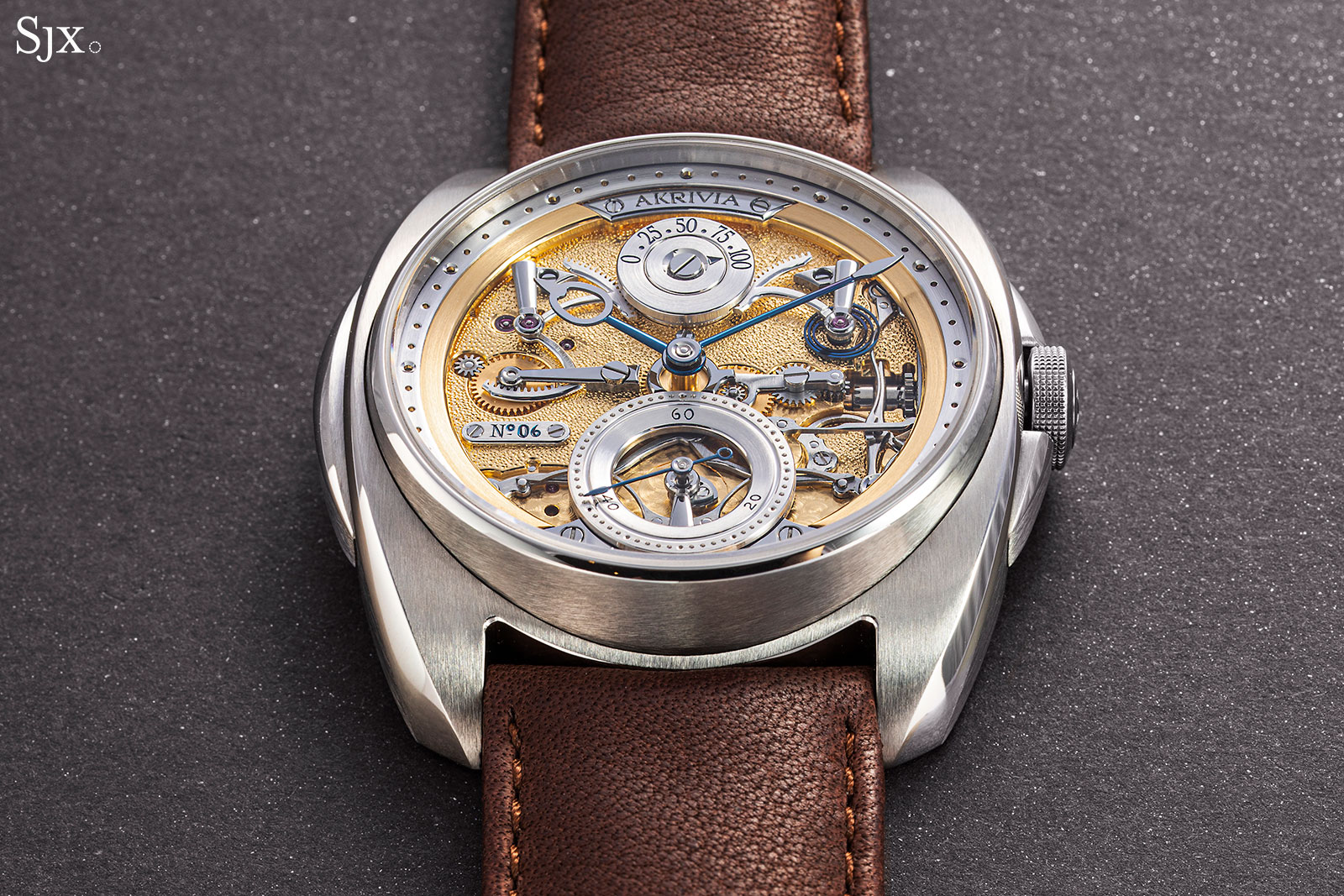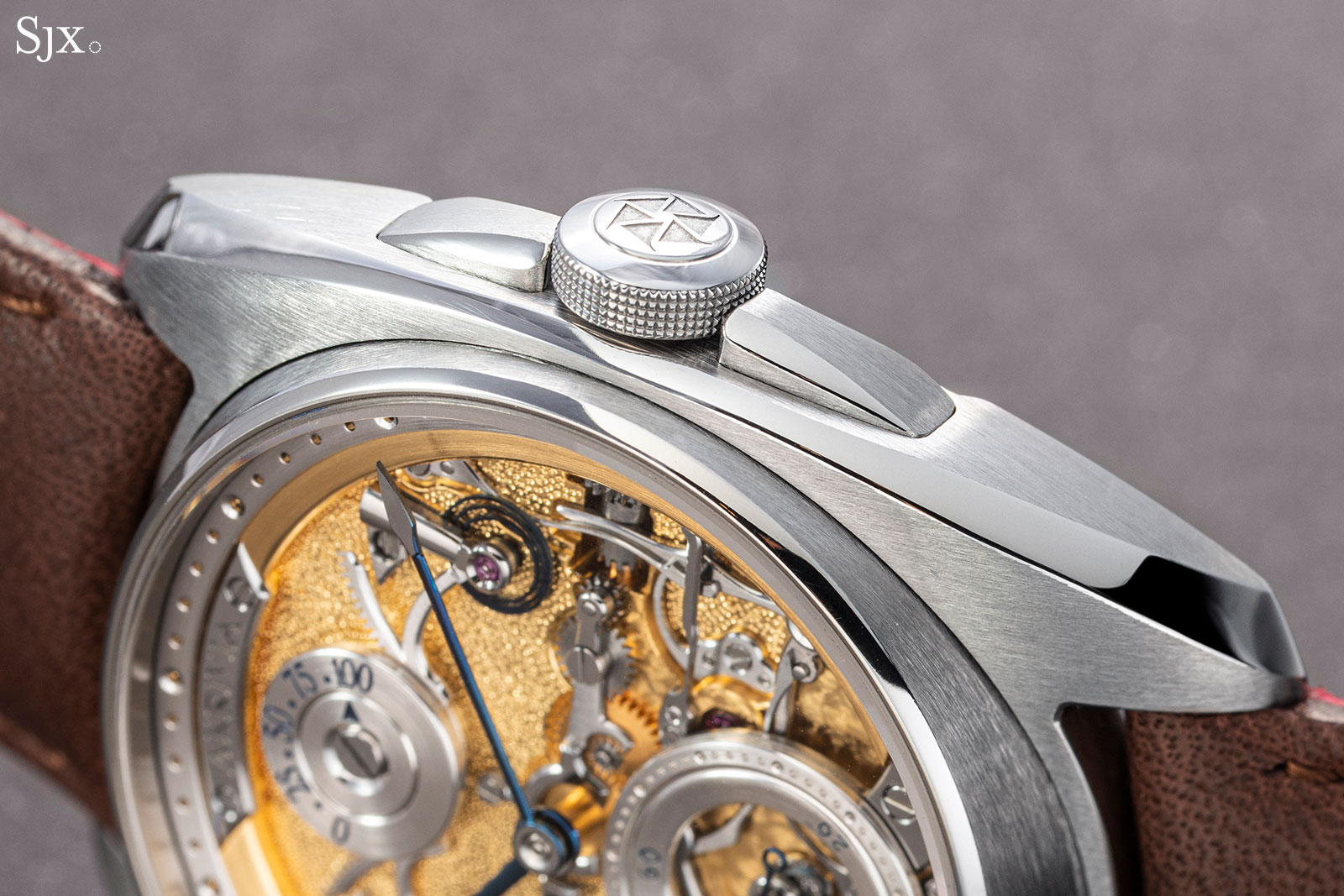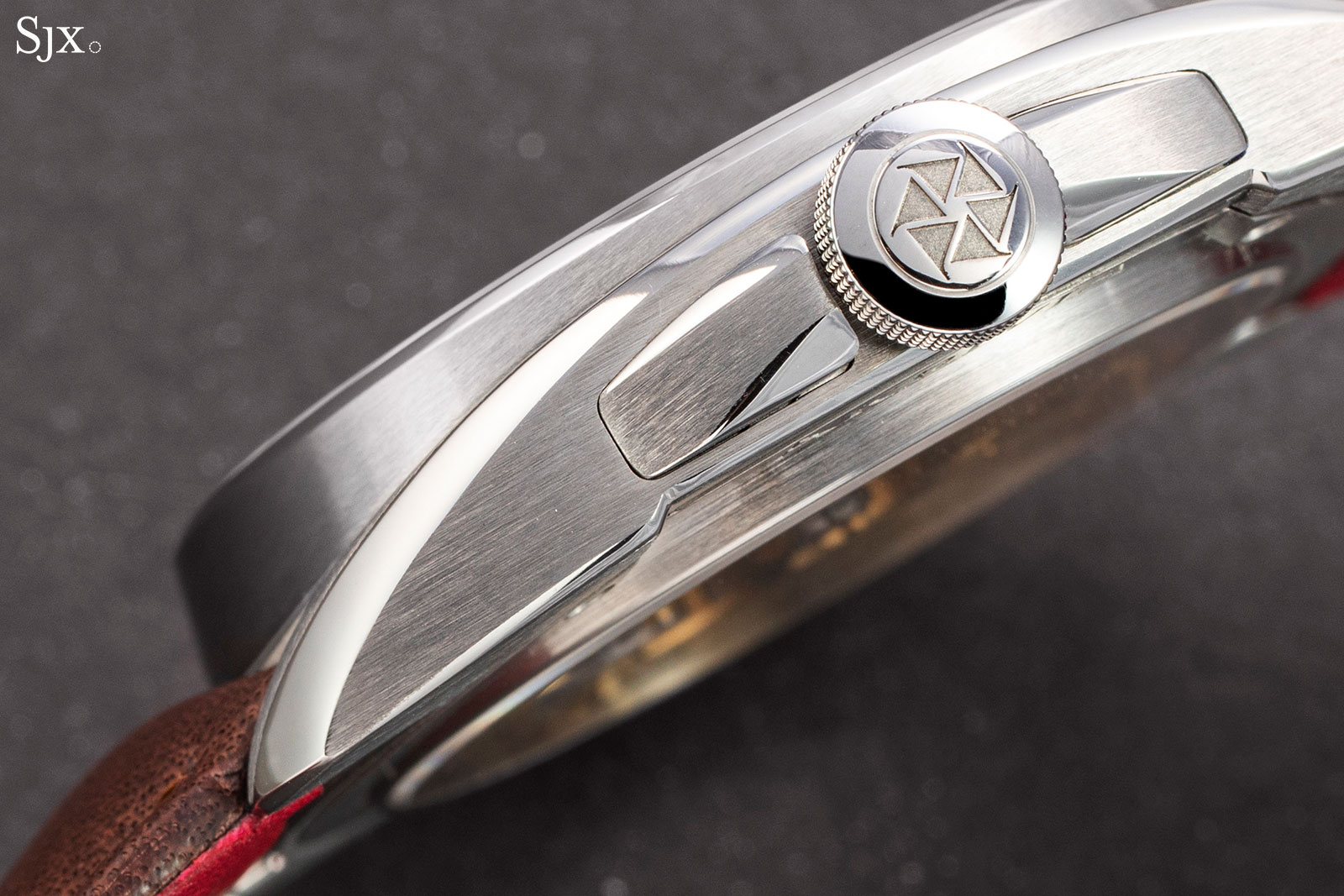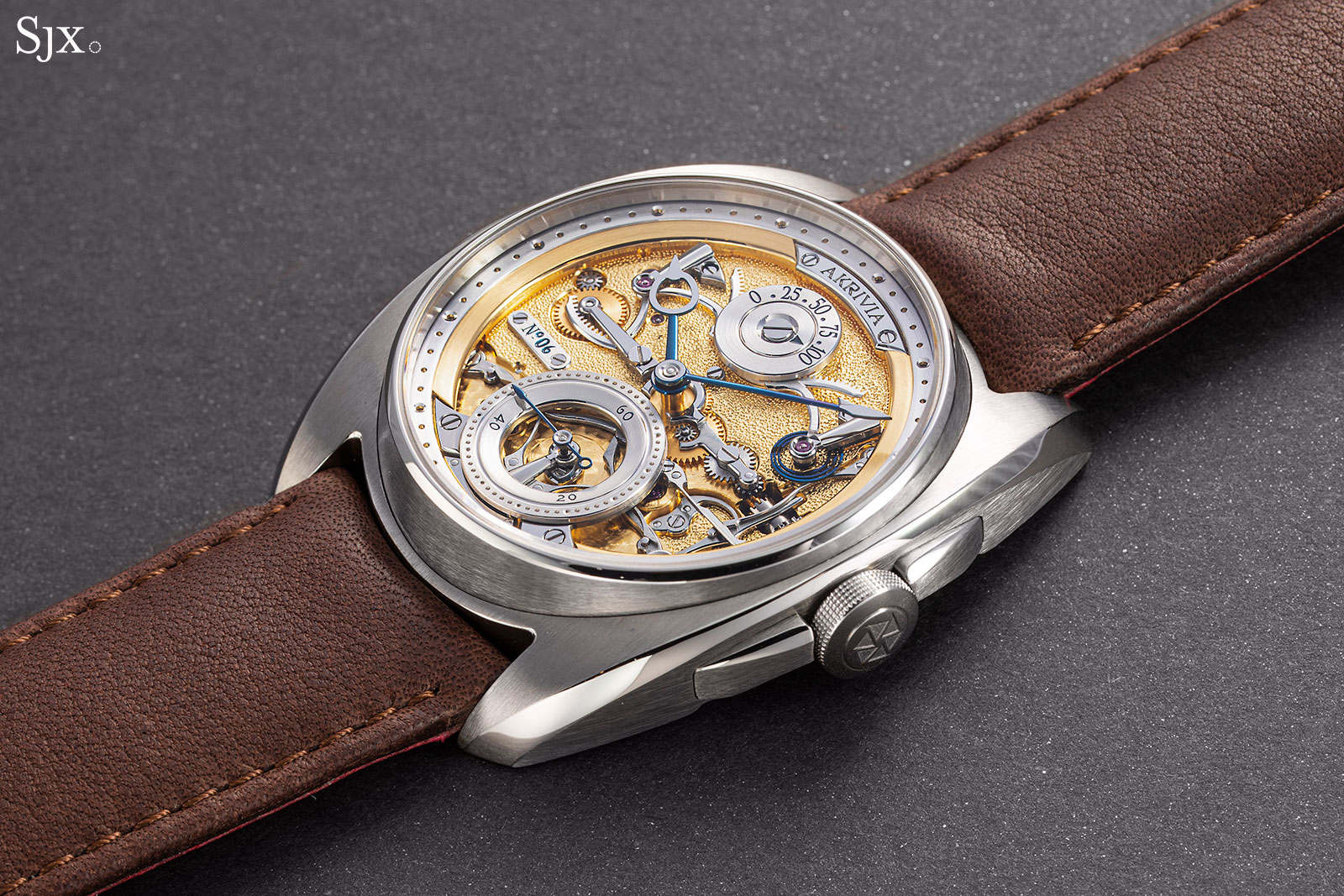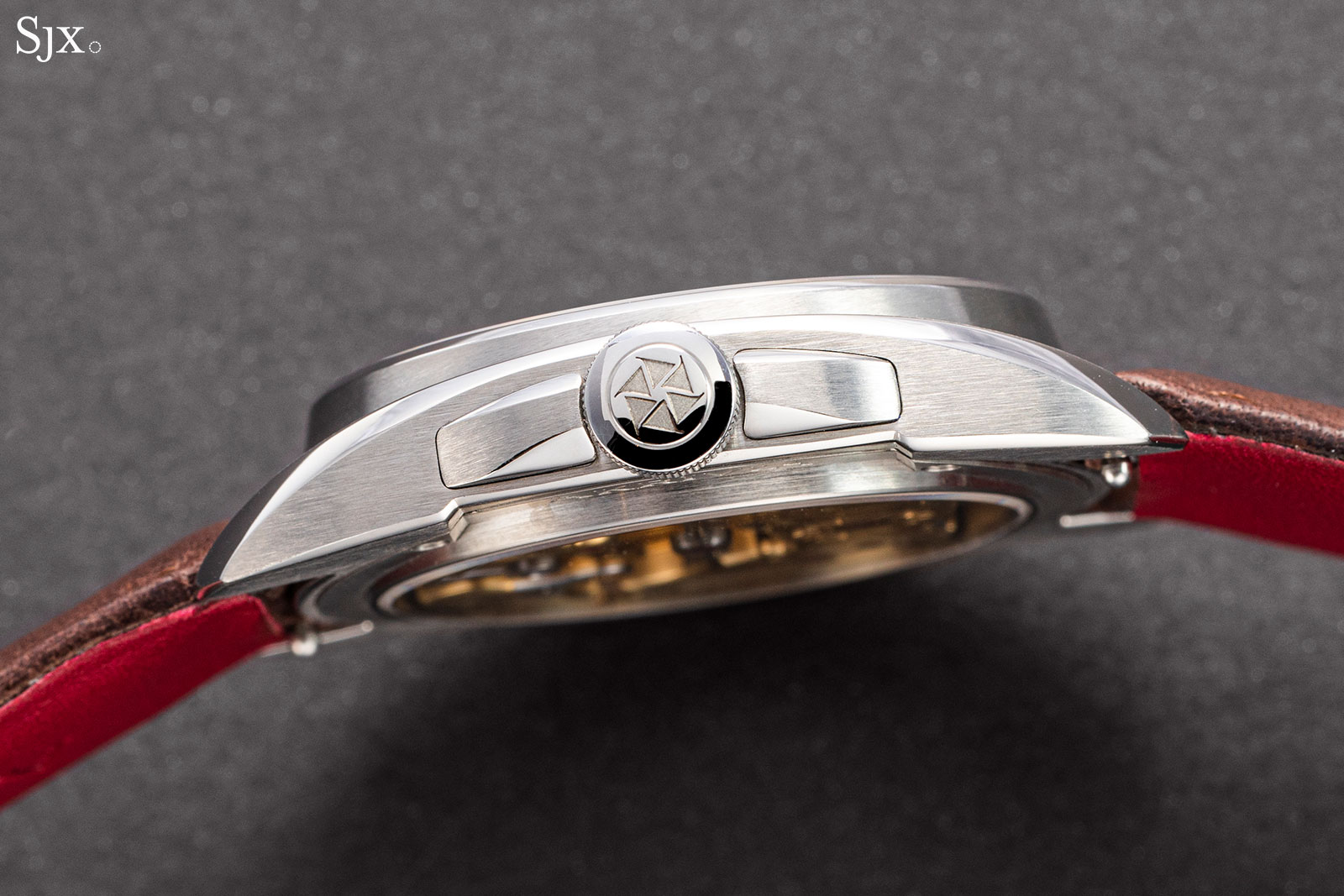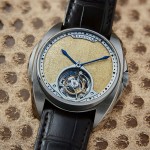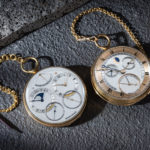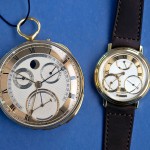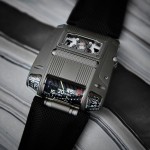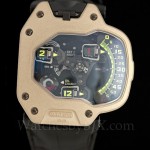Up Close: Akrivia AK-06
The foundational watch from a rising star.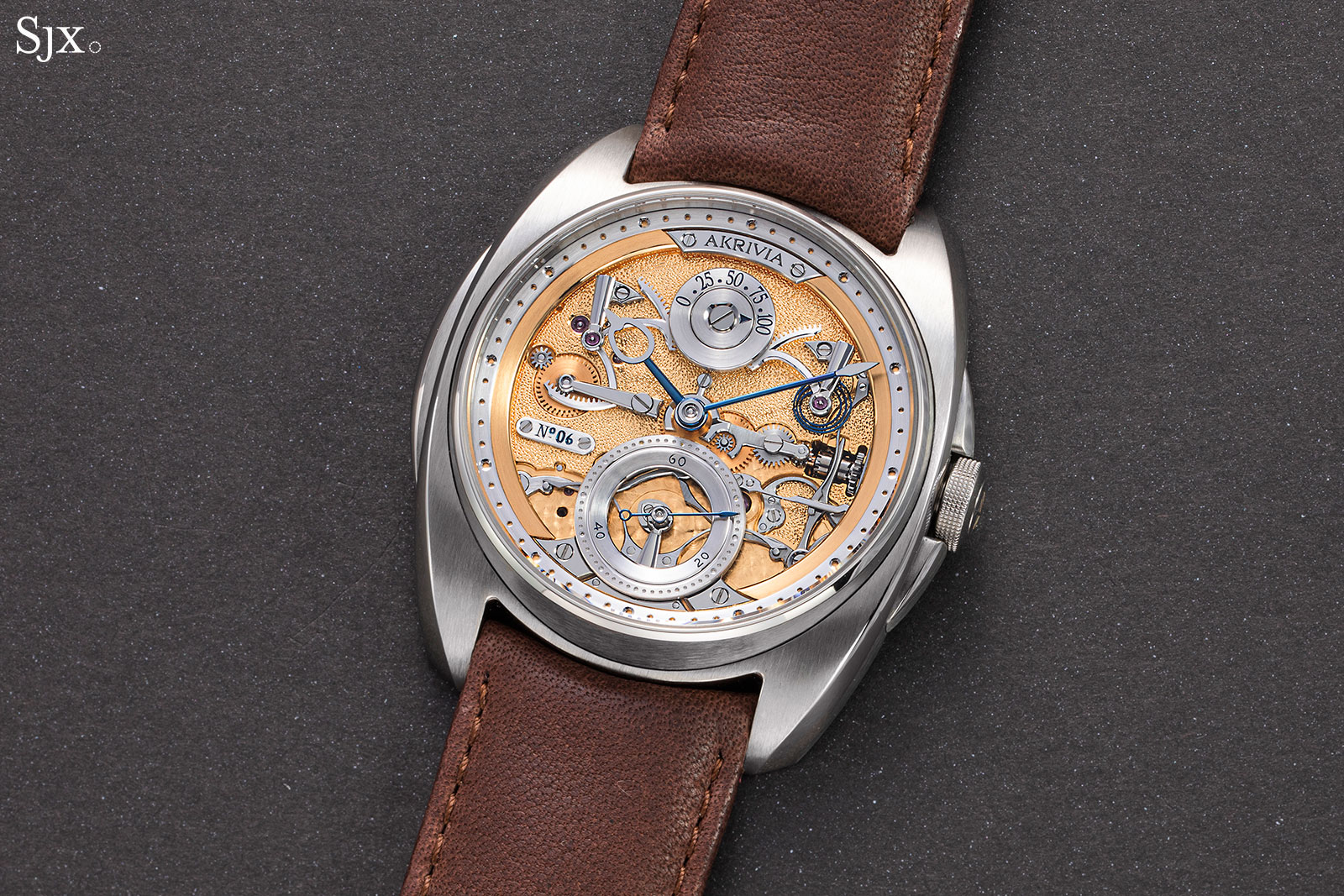
Akrivia, and by extension its founder Rexhep Rexhepi, became a star in independent watchmaking with the launch of the Chronometre Contemporain in 2018, a unique version of which went on to sell for 360,000 Swiss francs at charity auction Only Watch. While its success was recent, the brand was actually founded in 2012, having made its debut with the AK series, characterised by a wholly-different aesthetic, one that Rexhep himself describes as a startup’s attempt to make an impression.
The bridge between the twin collections of Akrivia – the contemporary AK series and the classical Chronometre Contemporain – is the AK-06. It’s powered by a variant of the movement found in the Chronometre Contemporain, but enhanced by doing away with the dial to reveal the under-dial mechanics, but installed inside an AK-style case, albeit one that’s been redesigned and streamlined.
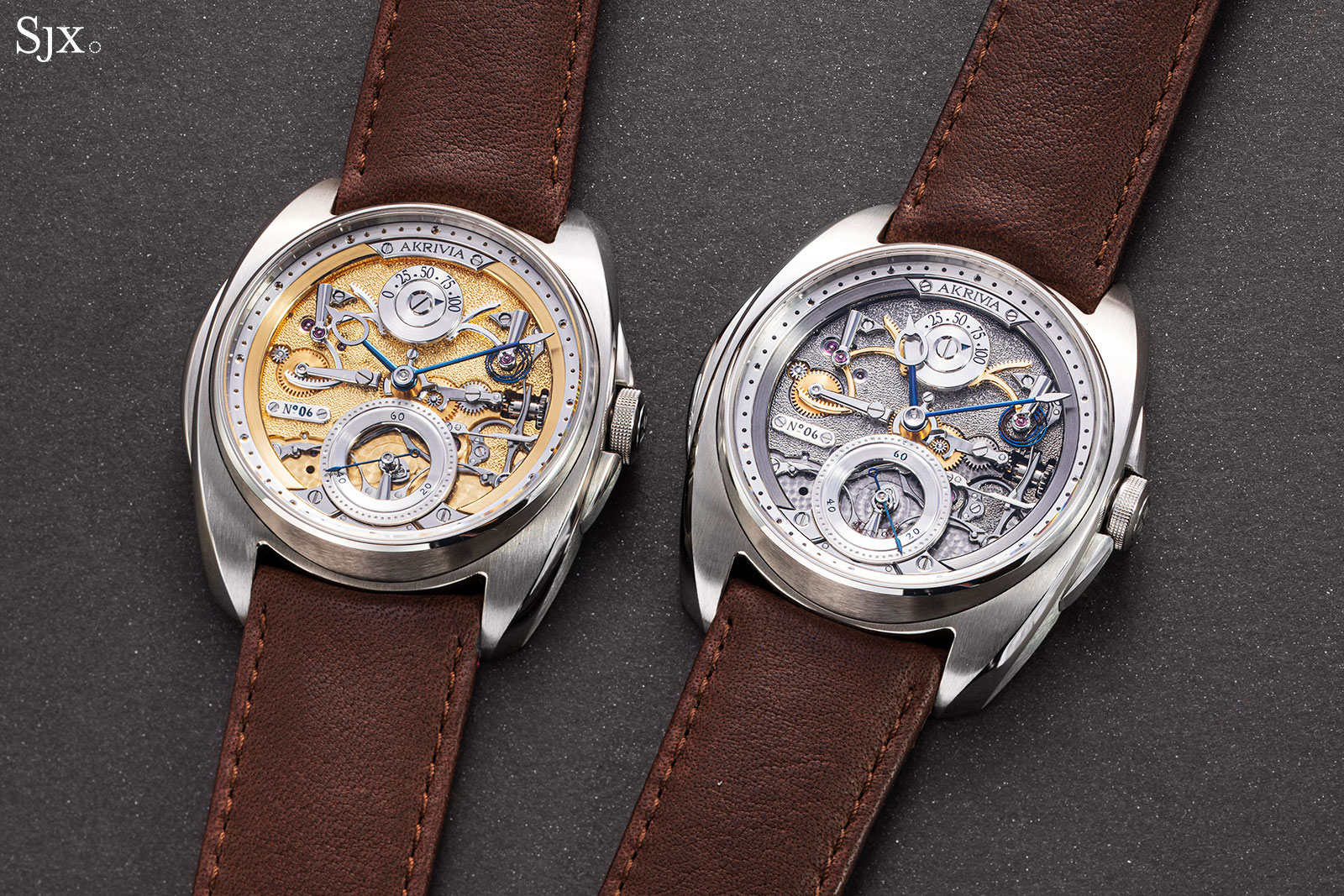
The AK-06 in titanium (left) and steel
Beyond being a blend of both Akrivia styles – the best of both worlds if you like the case design – the AK-06 is perhaps historically significant, being the last of the first-generation Akrivia models, since Rexhep has indicated the AK series will eventually feature a wholly new case design.
But whatever you think of the case, the movement of the AK-06 is absolutely marvellous. In fact, it is arguably more compelling than the similar calibre in the Chronometre Contemporain, because with the AK-06 all of its engaging mechanics are revealed on the front.
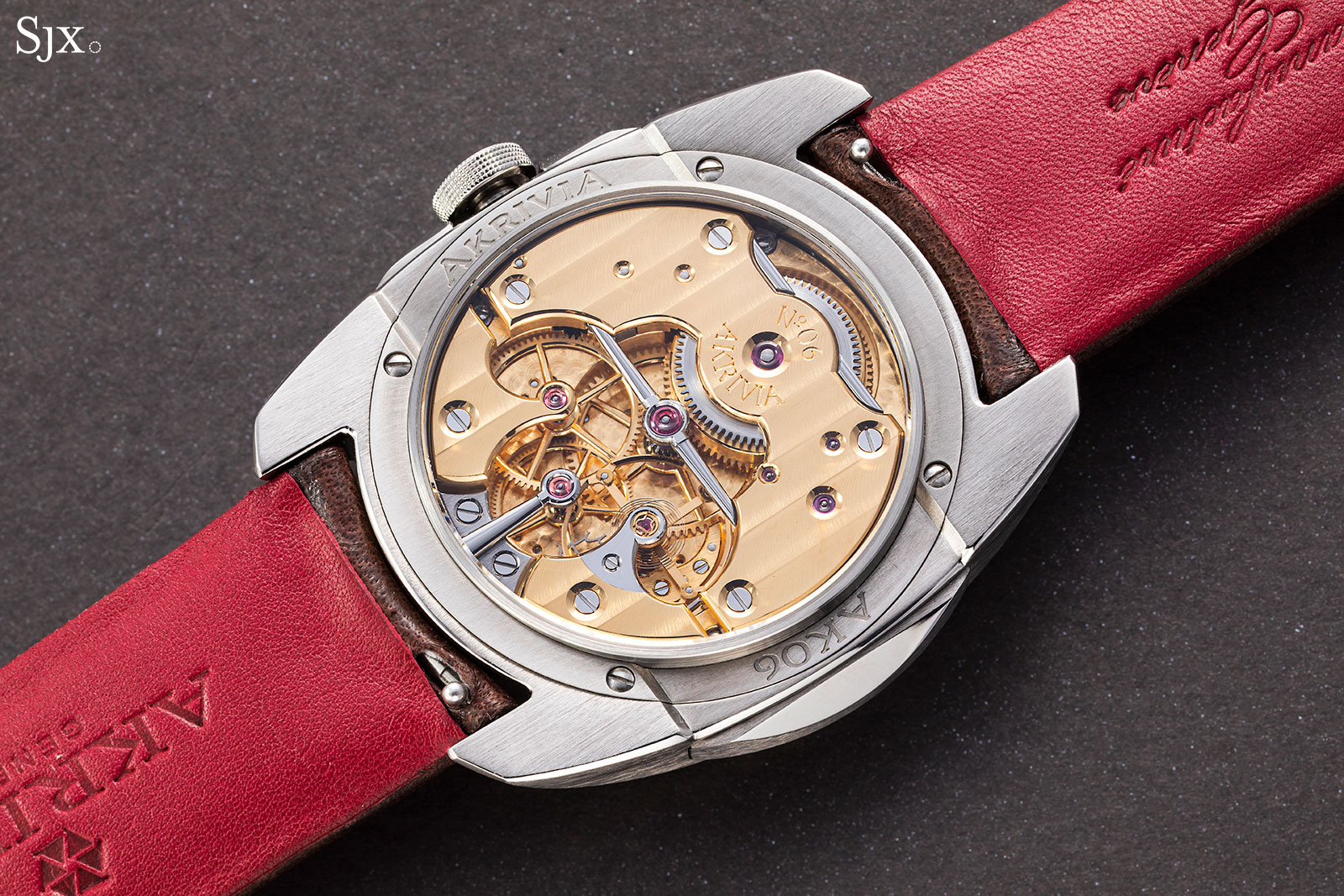
AK case
Everything that makes up the AK-06 is gorgeously finished, including the case. The case is finished with a fine, linear brushing, with the different planes separated with mirror-polished bevels.
Everything is expertly applied, even on the less obvious areas. The edge of the case between the lugs is chamfered and polished, as are the lower edges of the case flanks. Even the underside of the crown guard features a wide, polished bevel that slopes upwards, echoing the shape of the case.
Unusually for a watch with a movement of this quality, the case boasts a fairly complex shape with contrasting surfaces, requiring a good deal of effort to finish. In fact, the case is arguably the most complex for a movement in this class. Comparable watches like the Dufour Simplicity, Voutilainen Vingt-8, and even Akrivia’s Chronometre Contemporain, all rely on cases that are entirely mirror polished, as most classical watches are.
Importantly, the AK-06 case is a major refinement upon the original AK-case design. The AK-06 case is smaller – at 41 mm instead of 43 mm – and also thinner than the earlier generation, standing just 9.9 mm high. Though it appears to be bulky, it is substantially slimmer than it looks, and the watch wears well.
The chunky styling is why the case looks thicker than it actually is. The broad, short lugs, along with the “ears” on each side of the case give it a squat, heavy appearance – even though the case is surprisingly light and comfortable.
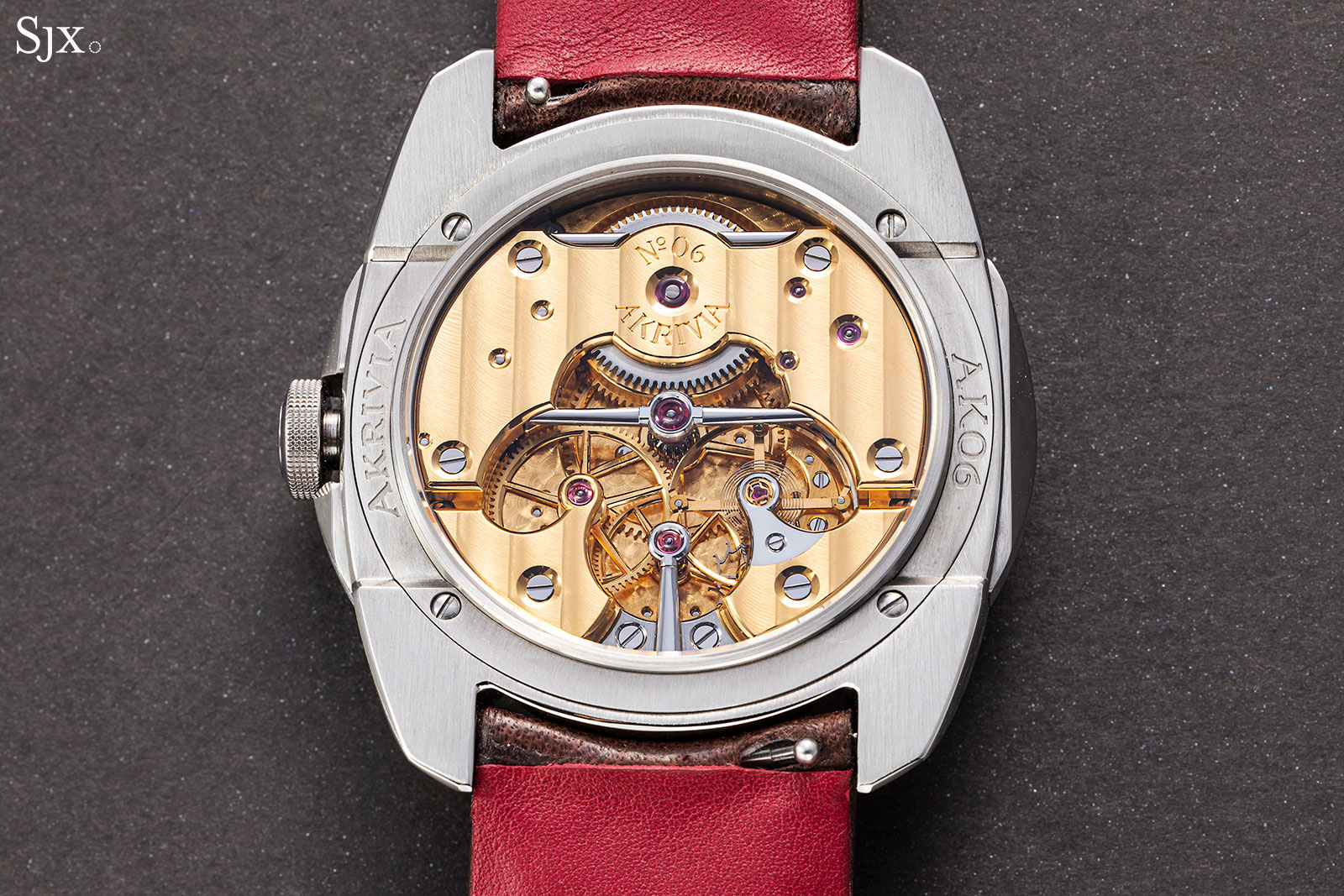
The case design is peculiar, and try as I might I can’t bring myself to love it.
But – but – the movement inside is just so well done that I could pretend the case isn’t there.
And in any case, no pun intended, Akrivia will eventually debut a new AK-case design that will succeed this one. In the grander scheme of things, the original AK-series case might become something significant, being the brand’s inaugural product.
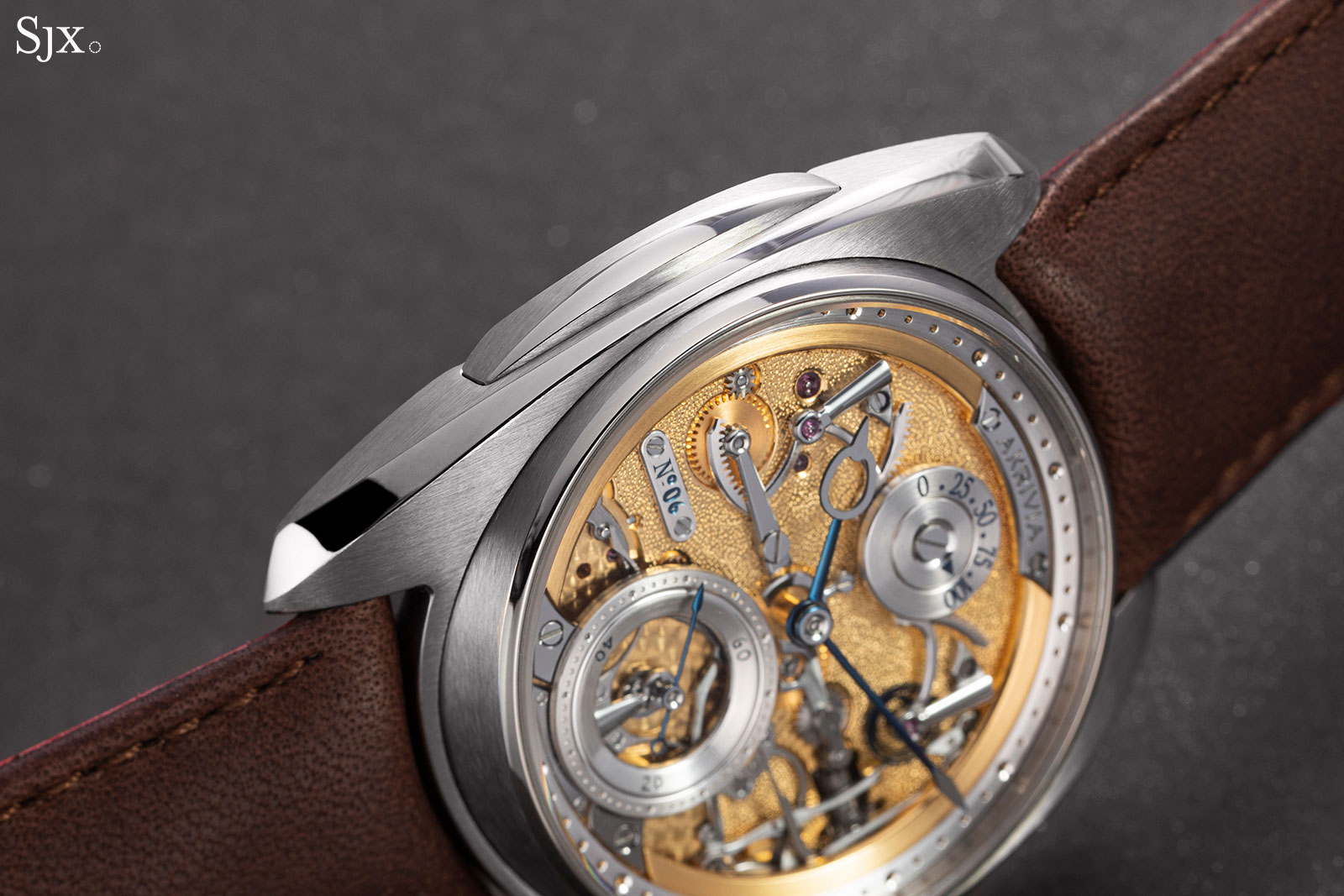
O why doth thou hath ears?
Open faced
The AK-06 has no dial, and instead shows off the striking, complex movement. Unlike the earlier AK-series watches, most of which were powered by movements conceived by Geneva specialist Manufacture Hautes Complications (MHC), the calibre AK-06 is proprietary, having been developed by the brand’s own constructor.
The front of the watch reveals the base plate, which is gold-plated brass and then finished with a dimpled pattern executed by hand, using a miniature hammer and a lot of patience. Though not unique to the brand, the hammered finish has become some of an Akrivia signature, and was combined with translucent, fired enamel for the dial of the record-setting Akrivia for Only Watch.
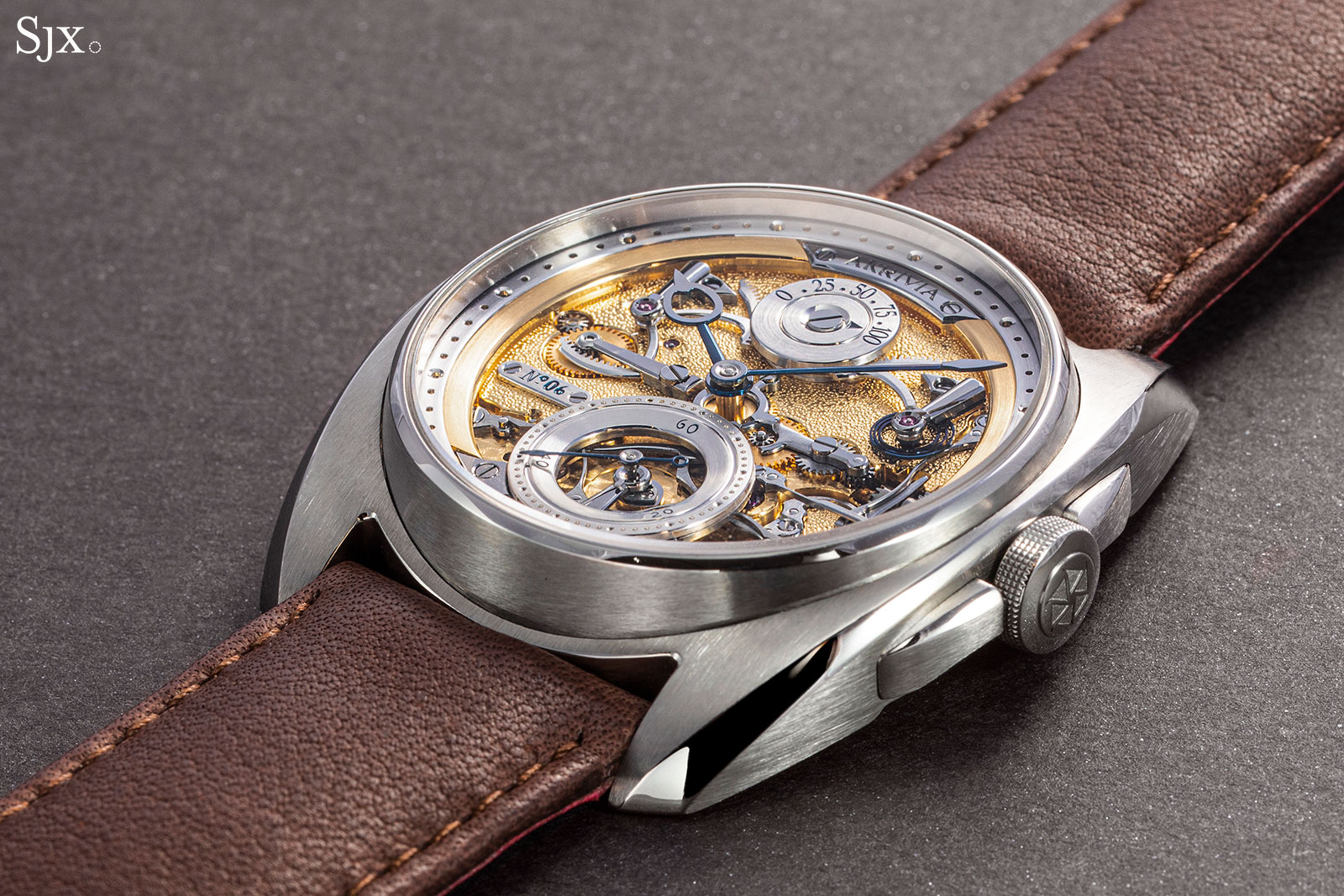
Interesting but not overwhelming, the hammered plate forms the perfect backdrop for the mechanics visible on the dial. At a distance it appears to be a glittery, granular surface, but up close the finishing technique is obvious.
The hammered texture is artfully done, though the refinement of the hammered finish varies between specimens. On some examples, including this one, some of the dimples overlap. Paradoxically, that is a compliment, because the overlapping dimples are one of the rare few aspects of the finishing that is average, rather than outstanding.
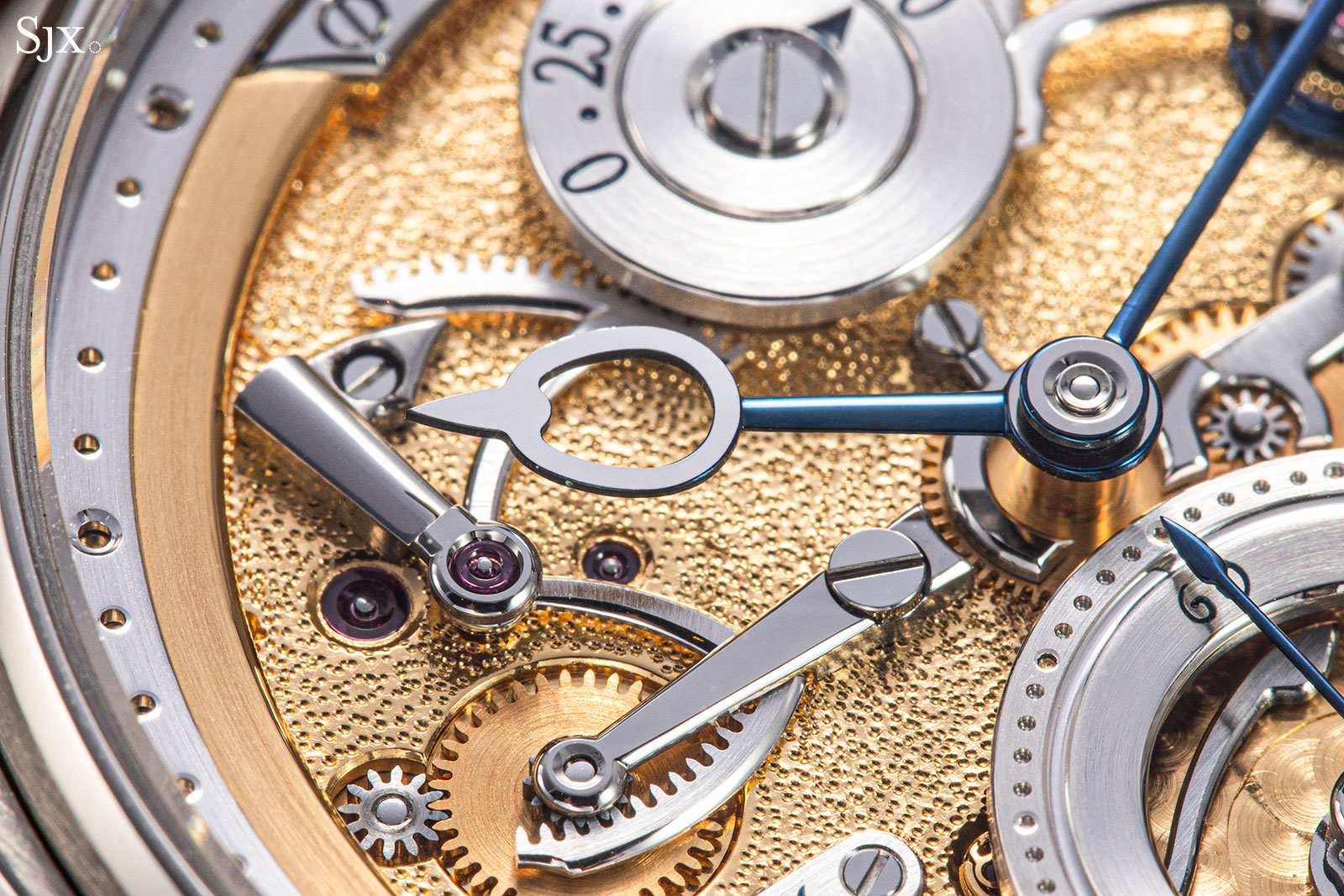
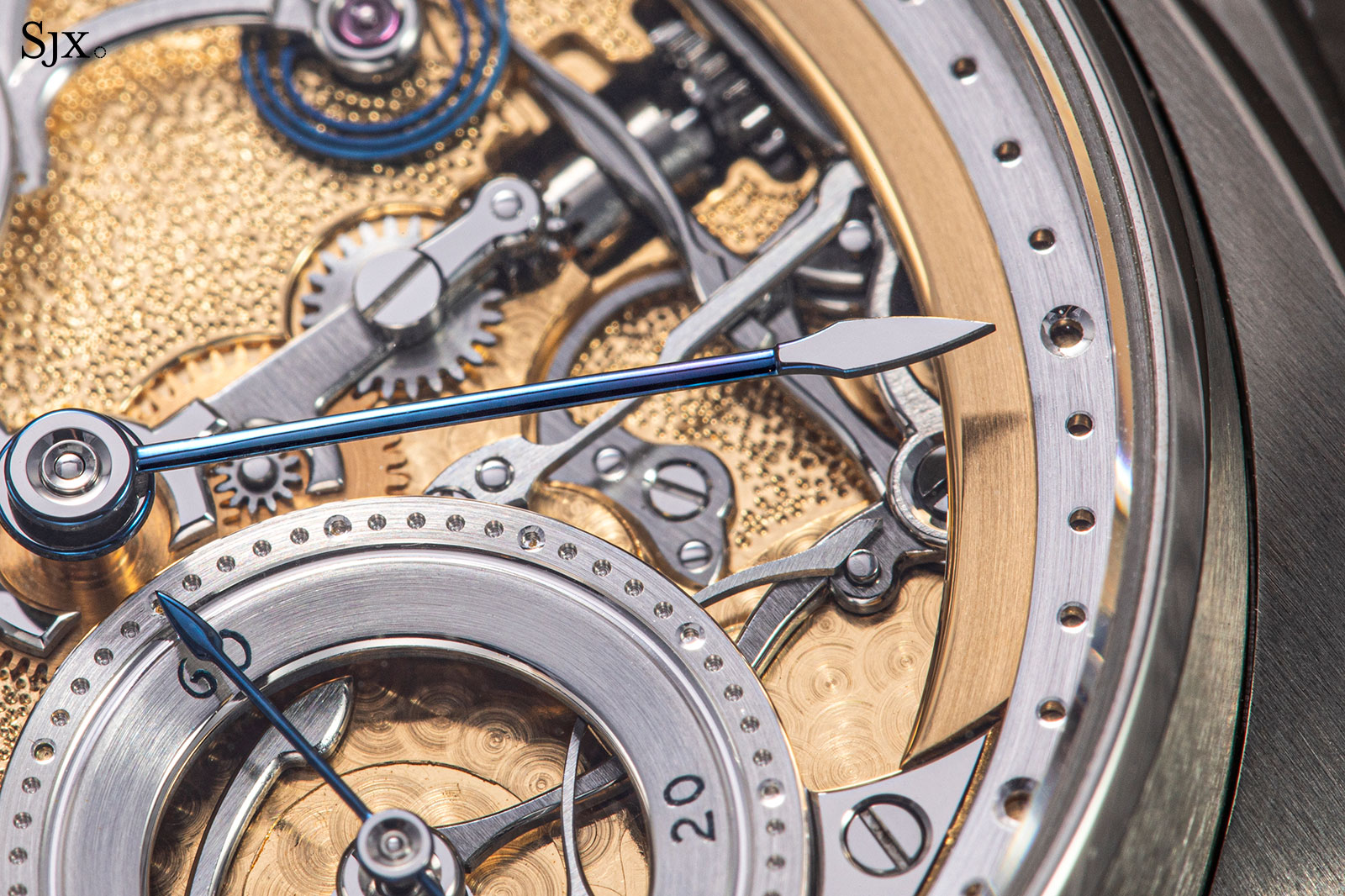
There are three main mechanisms visible on the dial: the power reserve display at 12 o’clock, the zero-reset for the seconds, and the keyless works at three. Although the mechanisms are fairly straightforward, they are constructed so that the face is balanced, made up of components that are long and elegant, resulting in an intricate but refined look.
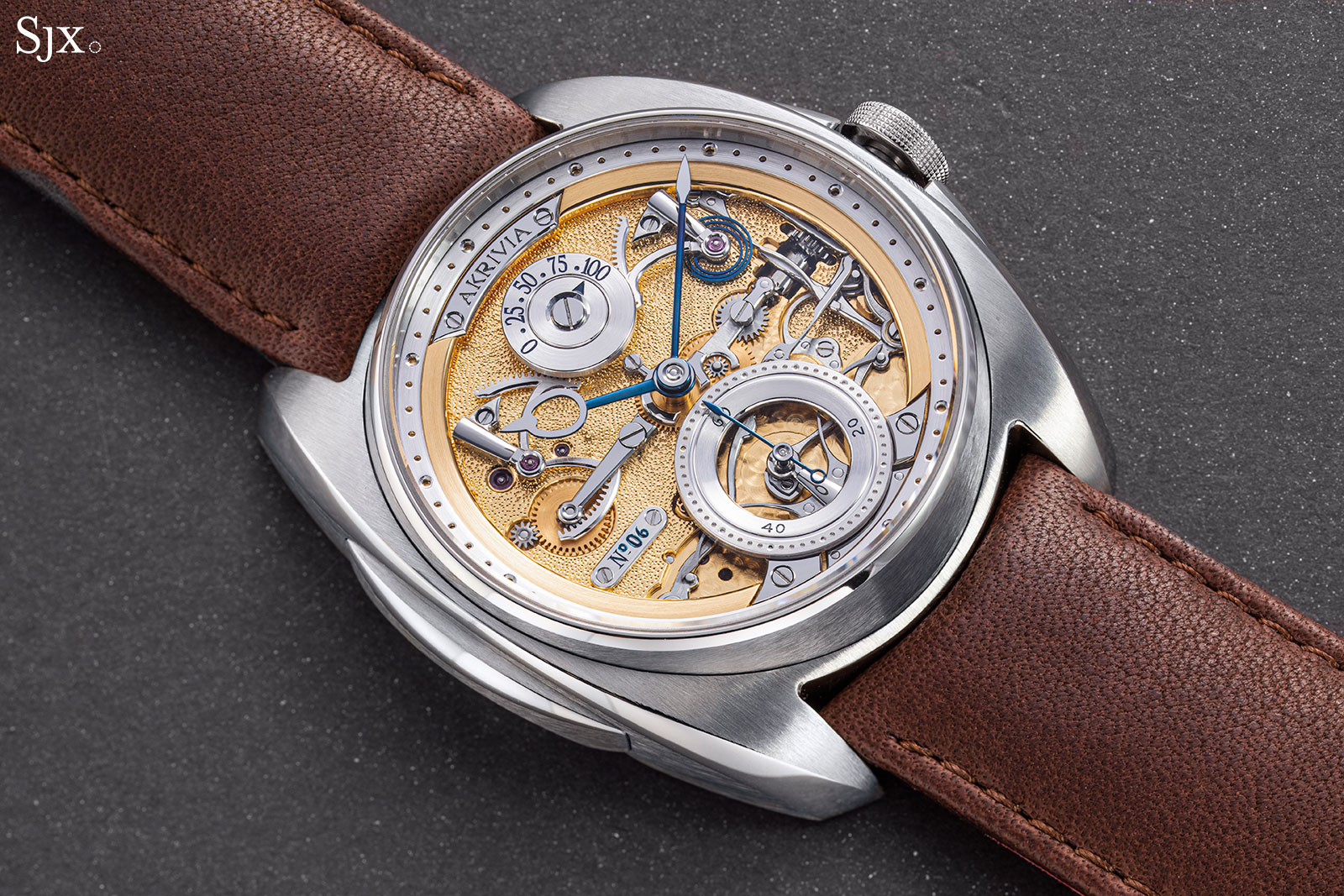
Shown on a circular scale, the 100-hour power reserve display is driven by one rack and kept in check by another. The construction of the power reserve display is concise and symmetrical.
The rack at nine o’clock is connected to a set of gears that measure the barrel’s state of wind, while the other rack connects to a coiled, blued-steel spring that maintains the tension within the indicator so that it doesn’t drift when the watch is dropped or shaken.
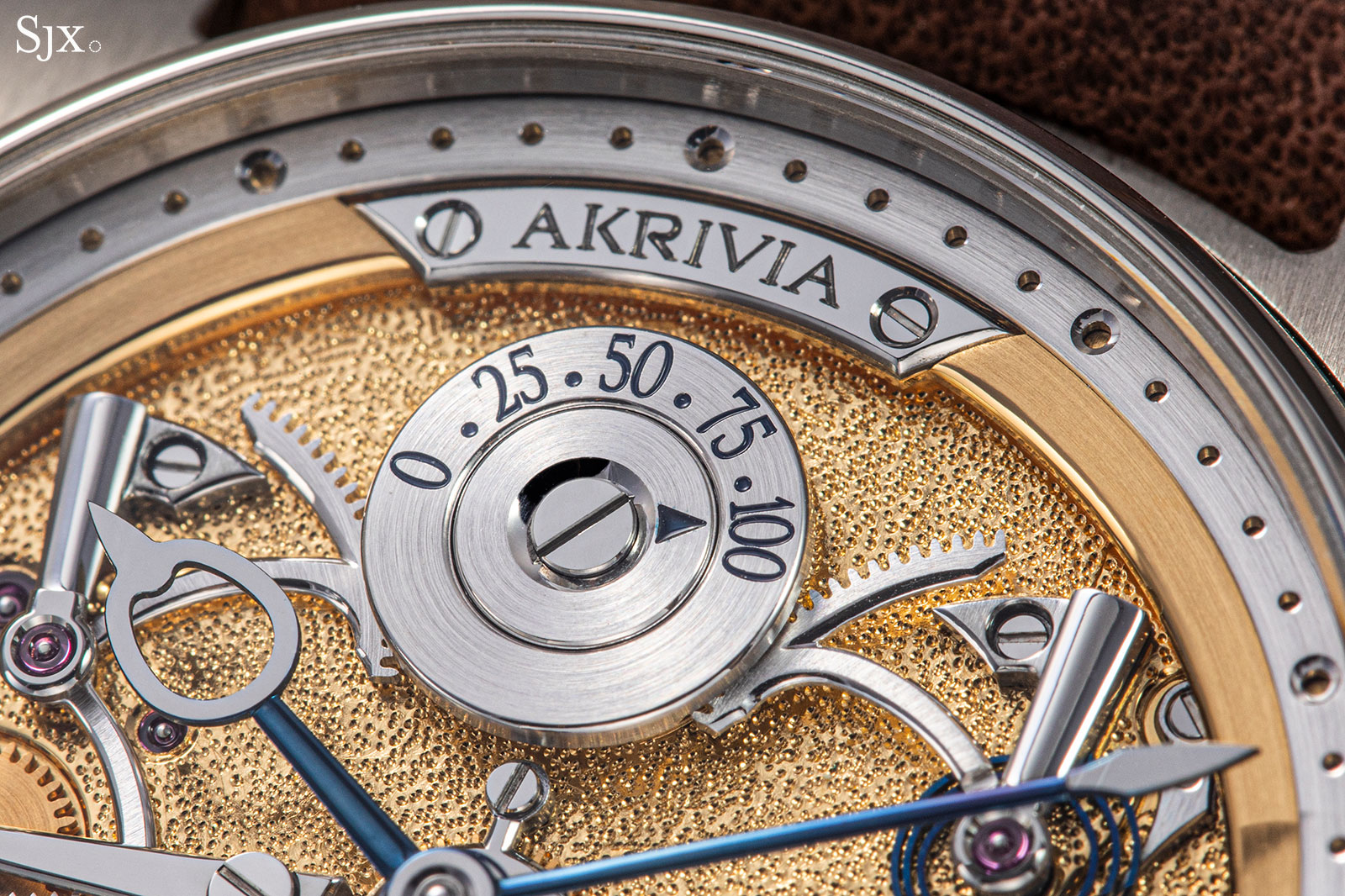
Interestingly, the scale engraved on the power reserve display is machine-engraved, instead of being hand-engraved as most of the other markings on the dial are
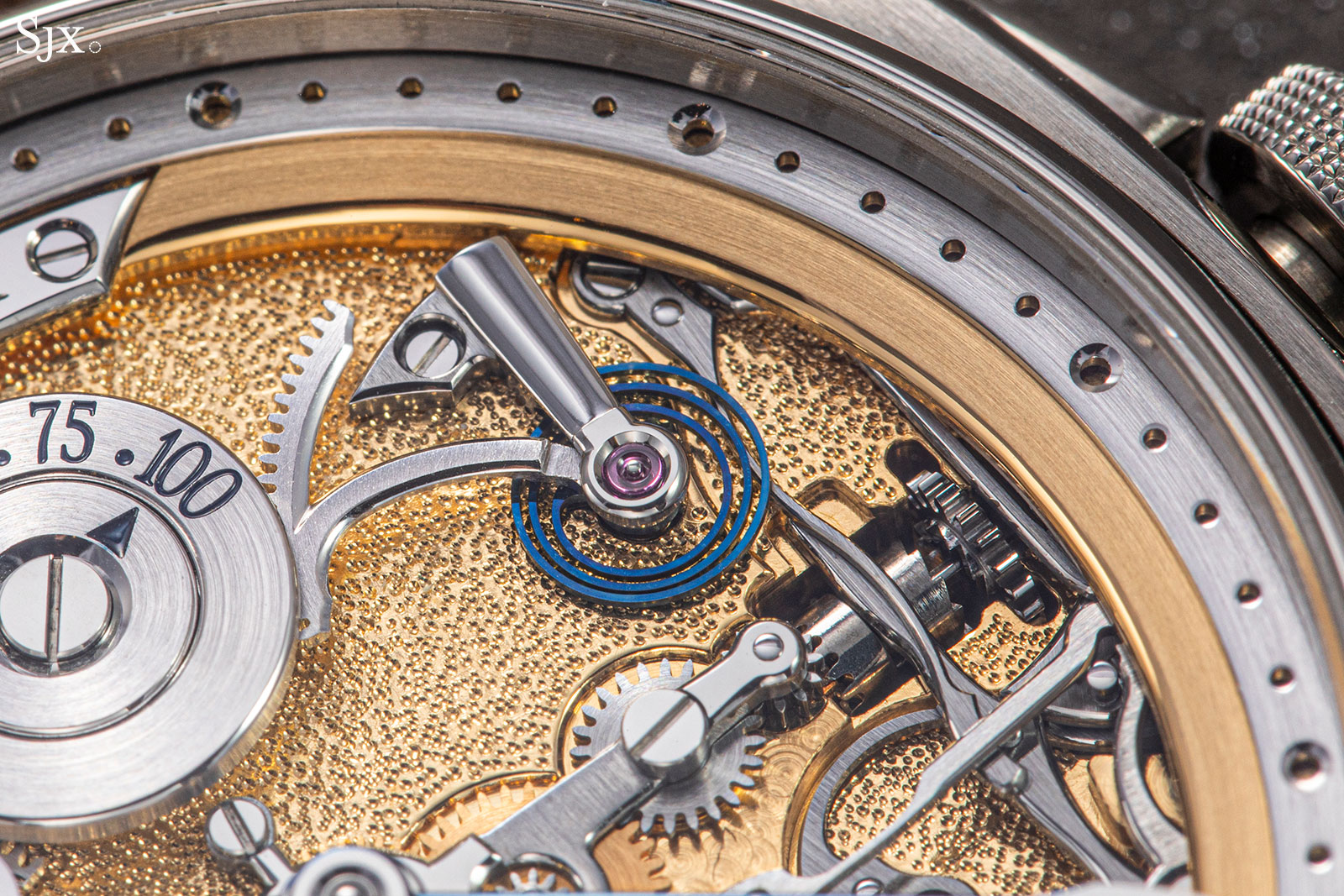
The heat-blued tension spring for the power reserve display
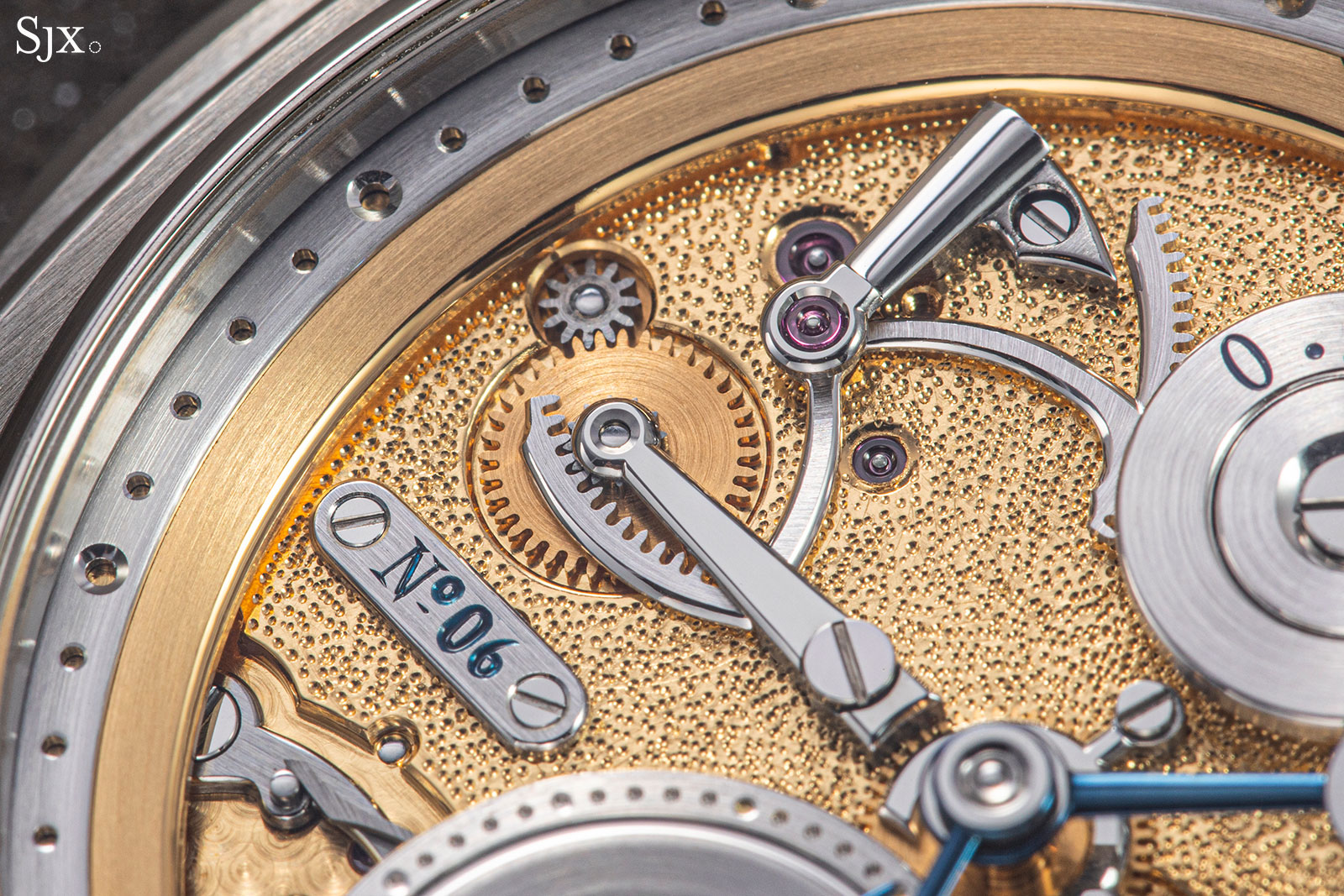
The rack on the left is linked to the differential under the dial that measures the state of wind of the mainspring
The power reserve mechanism reflects the approach taken for the movement as a whole: not only is it smartly constructed, all of its components are also beautifully finished. Each of the racks, for instance, have circular graining on the top surfaces, along with polished, bevelled edges on the arms and outer edge.
In fact, the components have been carefully designed to show off different types of decoration. Take for instance the cocks for several of the moving parts, and there are many, even the seconds hand has its own cock.
Both sets of racks are secured by mirror-polished, rounded steel cocks of the sort typically used for the balance wheel or tourbillon cage. In contrast, the visible wheels on the dial (one for the power reserve and the other, the keyless works) are held in place with flat-topped, black-polished cocks.
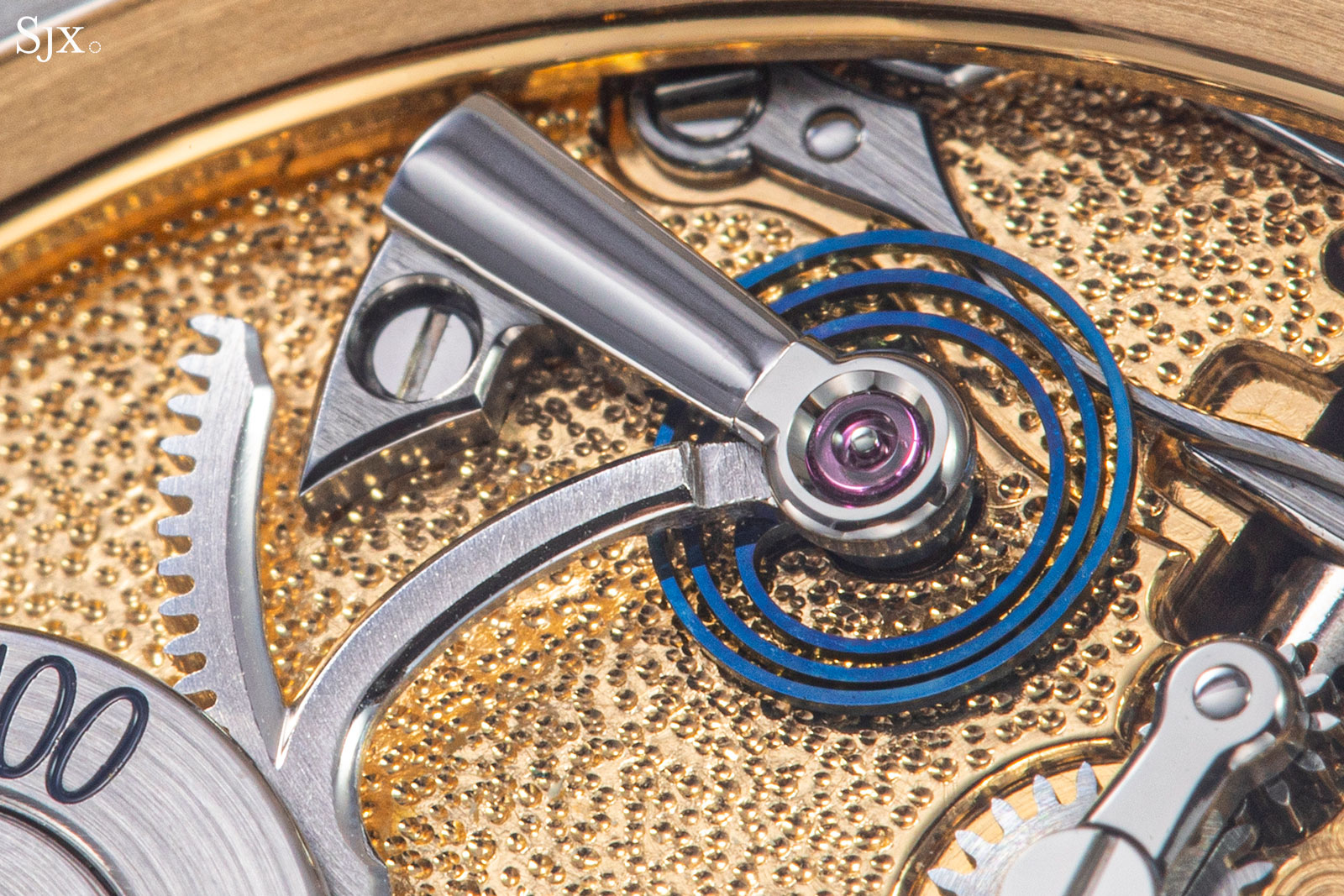
One of the rounded cocks, this one also holding the tension spring for the power reserve indicator
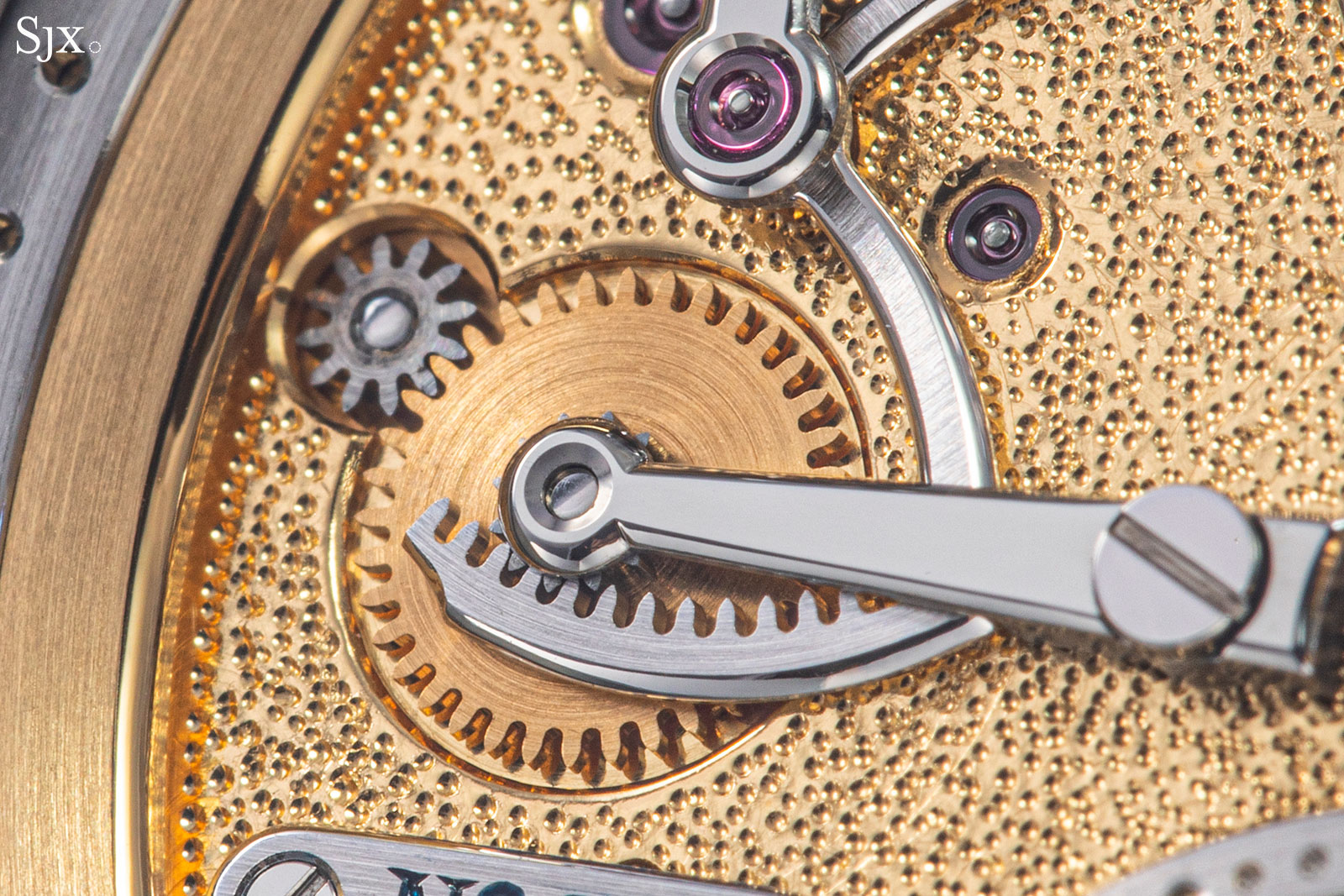
The flat-topped cock holding the wheel that connects the differential under the dial to the power reserve indicator
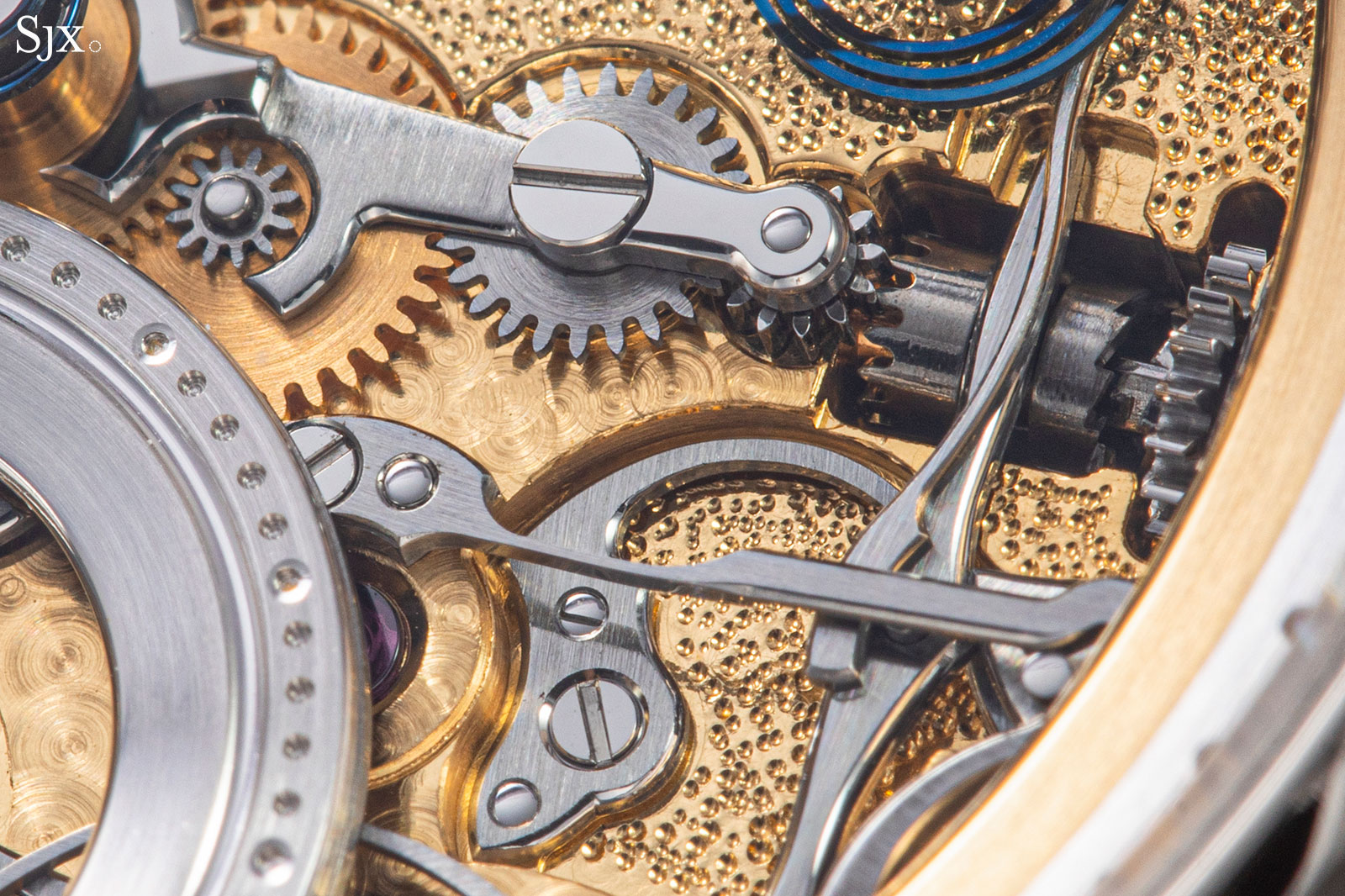
The other bridge for the keyless works that move the hands when setting the time
Less prominent than the power reserve mechanism but perhaps even more elegantly executed is the subsidiary seconds and its zero-reset mechanism – pull out the crown and the seconds hand returns to “60” for more precise time setting.
The zero-reset relies on two arms and a heart-shaped cam, essentially operating on the same principles as a chronograph reset mechanism. But in this case – much like the rest of the watch – the mechanism was designed to be as symmetrical as possible, with each arm tensioned by an elongated, arched tension spring.
The chapter ring for the seconds, however, falls a bit short of the rest of the watch. While it is finished as well as everything else, the engraved numerals are not as well done as the rest of the engraving, with the “60” looking a bit untidy. Along with the machine-engraved power reserve scale and heavily serifed serial number, there are three styles of engraving on the dial, which is one too many.
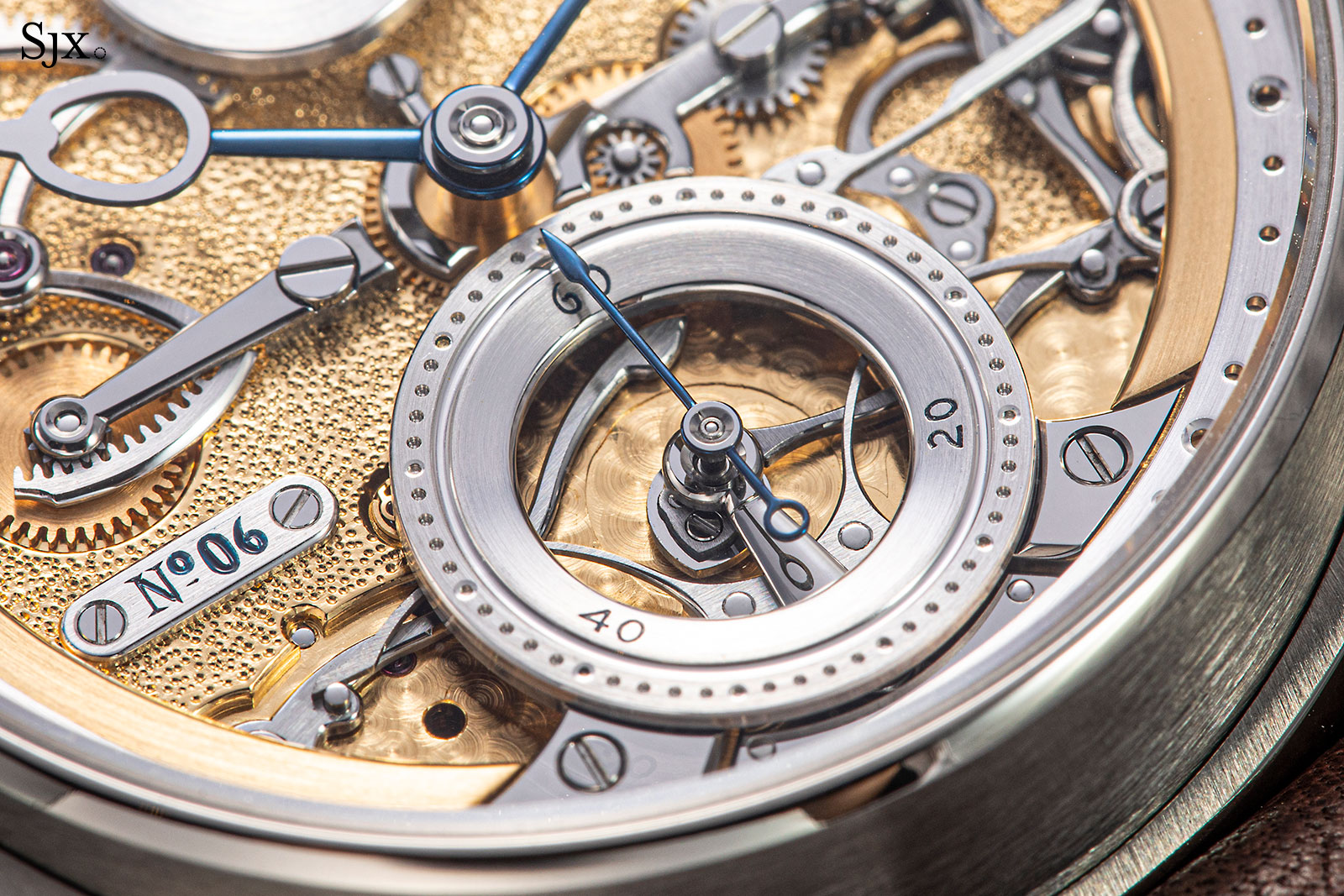
The zero-reset seconds, with the seconds hand held by its own rounded steel cock, and heart-shaped cam visible just above the surface of the base plate
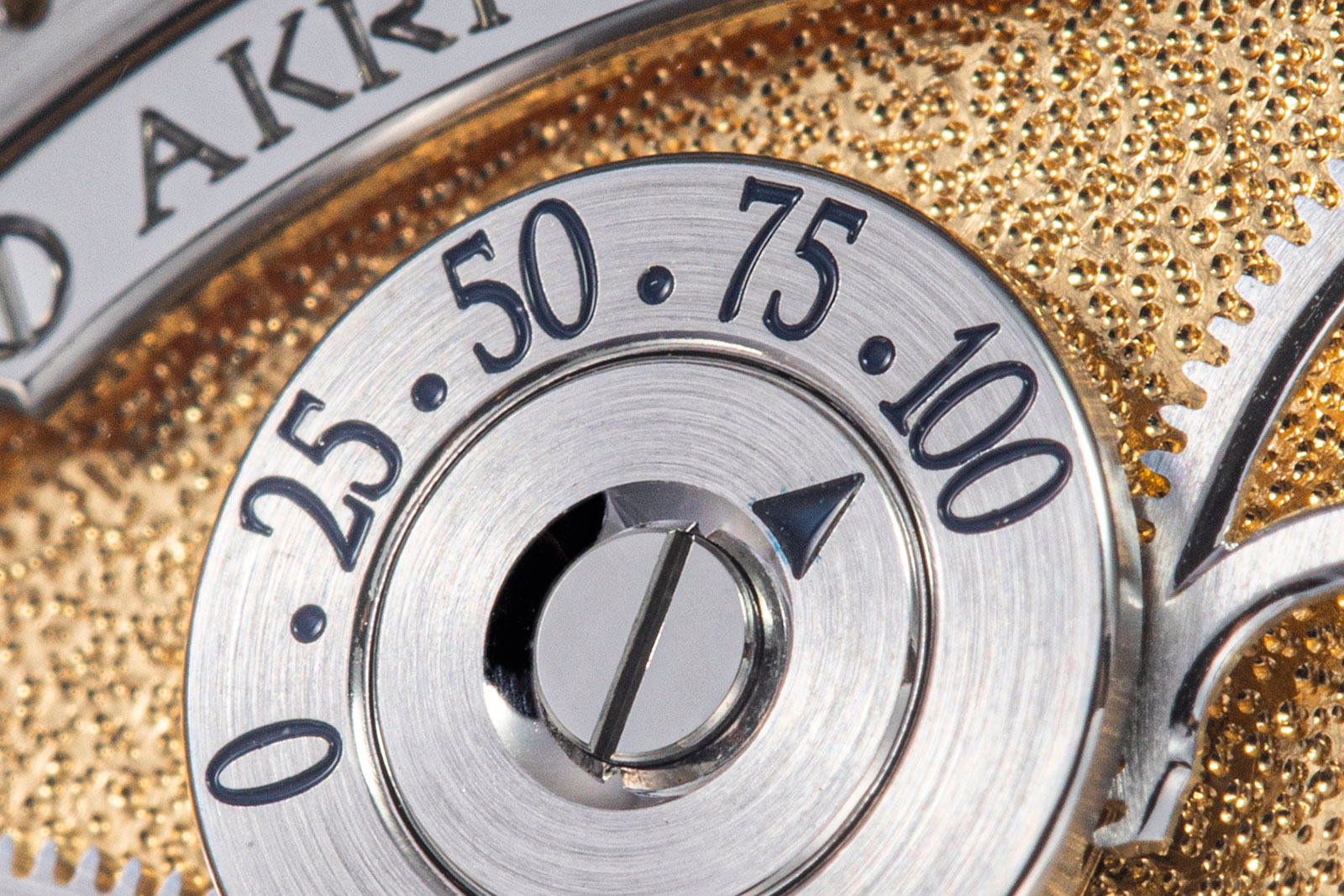
Machine engraving on the power reserve scale
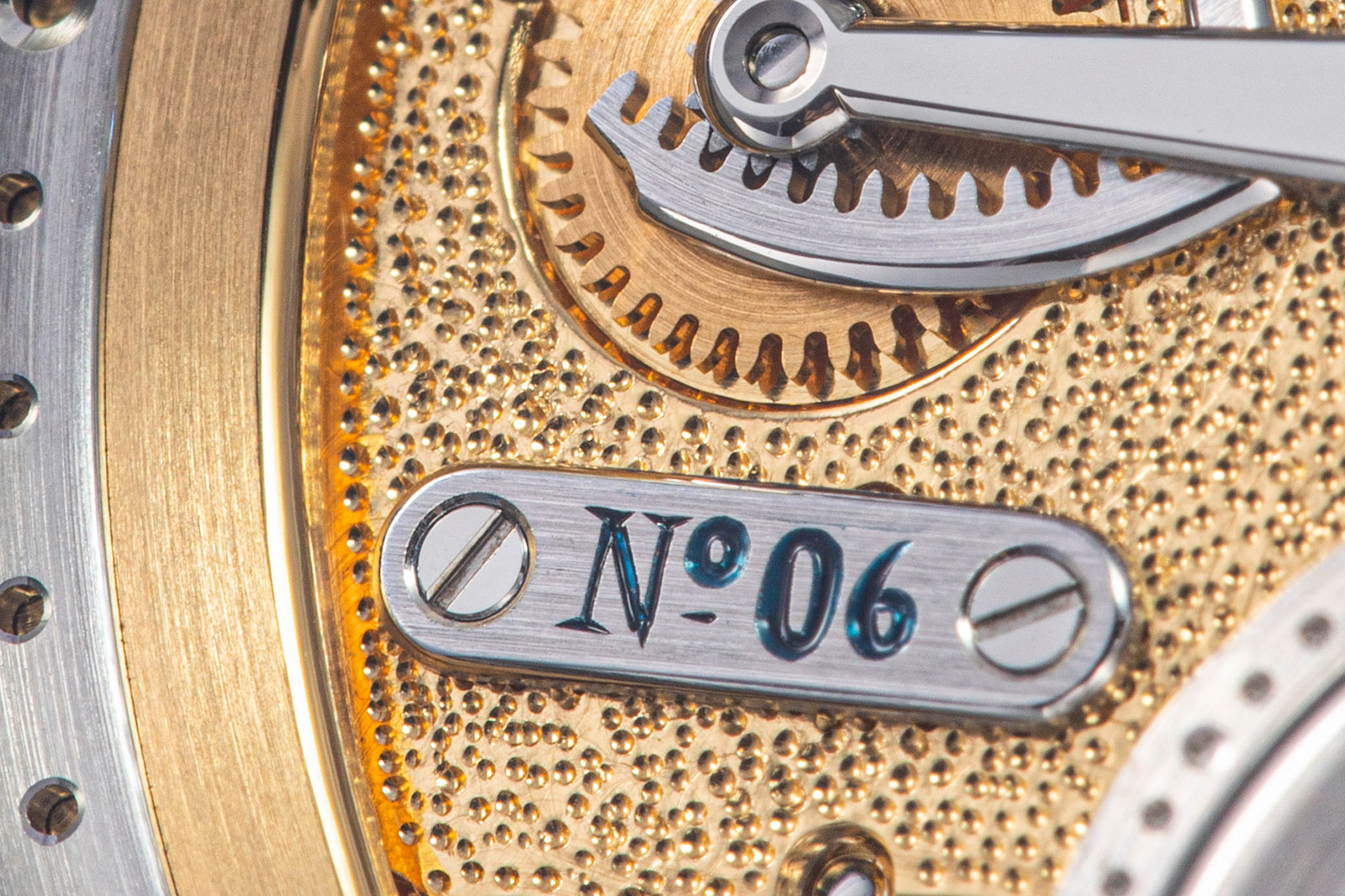
And hand engraving for the serial number
Of all the mechanisms visible on the front, the keyless works are the most ordinary in terms of function, but are nonetheless wonderfully executed in construction and finish. The use of long, curved springs continues, along with careful finishing of even the smallest element.
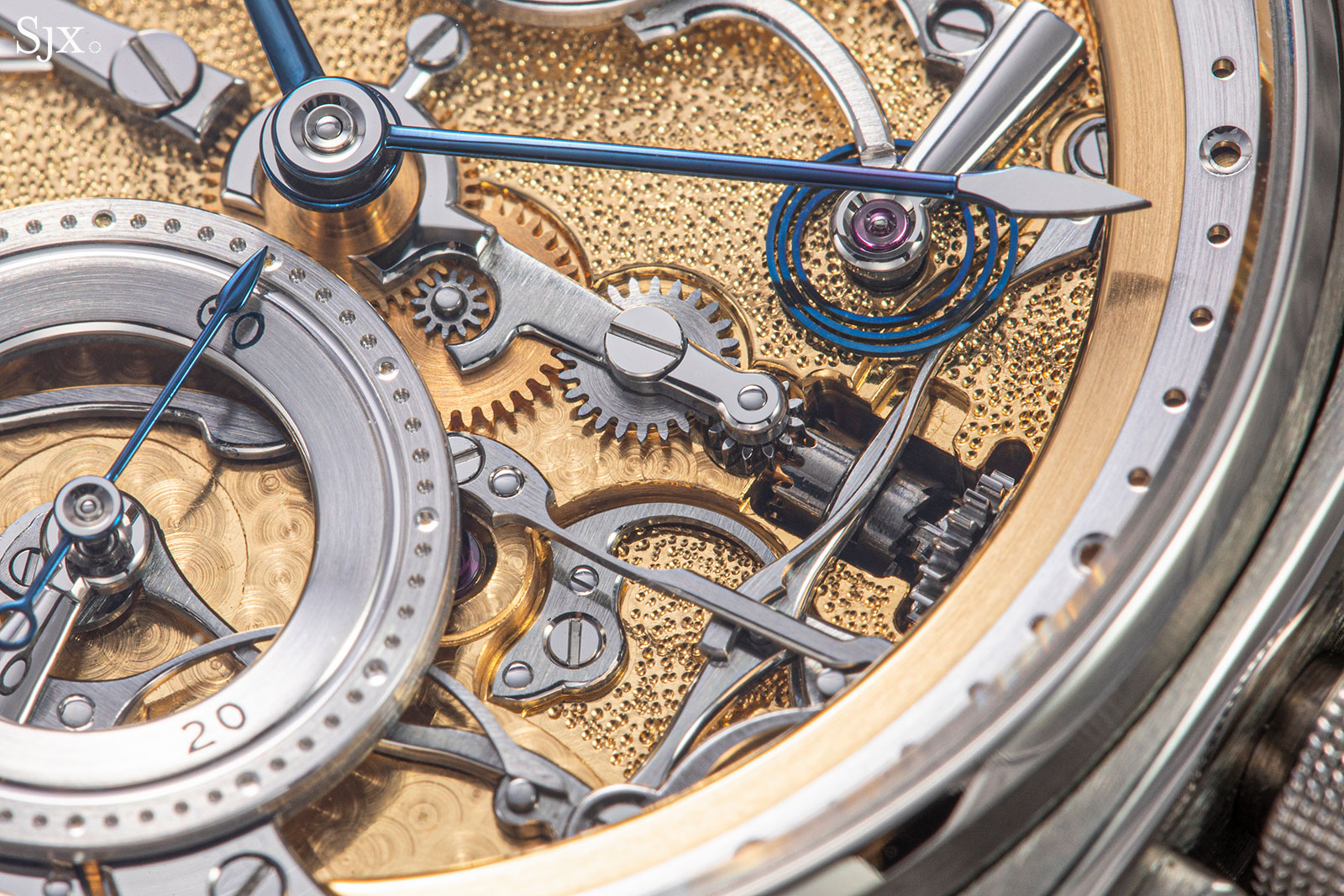
One element of the dial that I struggle to appreciate are the hands, or more specifically, the hour hand. It reminds me of a grape on toothpick. Fortunately, the minute hand is a conventional lance-shape.
Design aside, the finishing of the hands is unwavering: heat blued, rounded, and mirror polished. In fact, the finishing is so sharply done that the minute hand looks almost dangerous at high magnification.
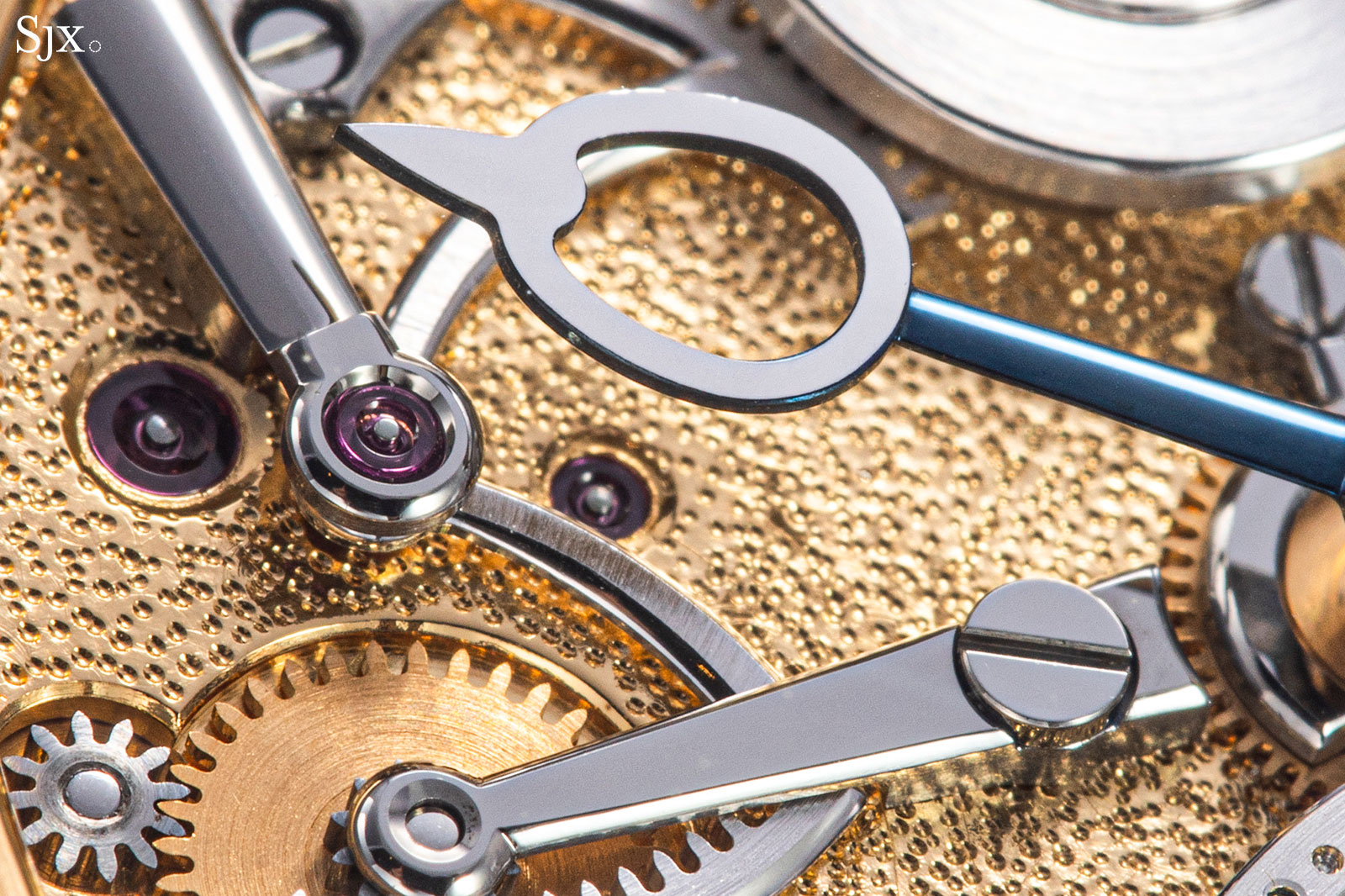
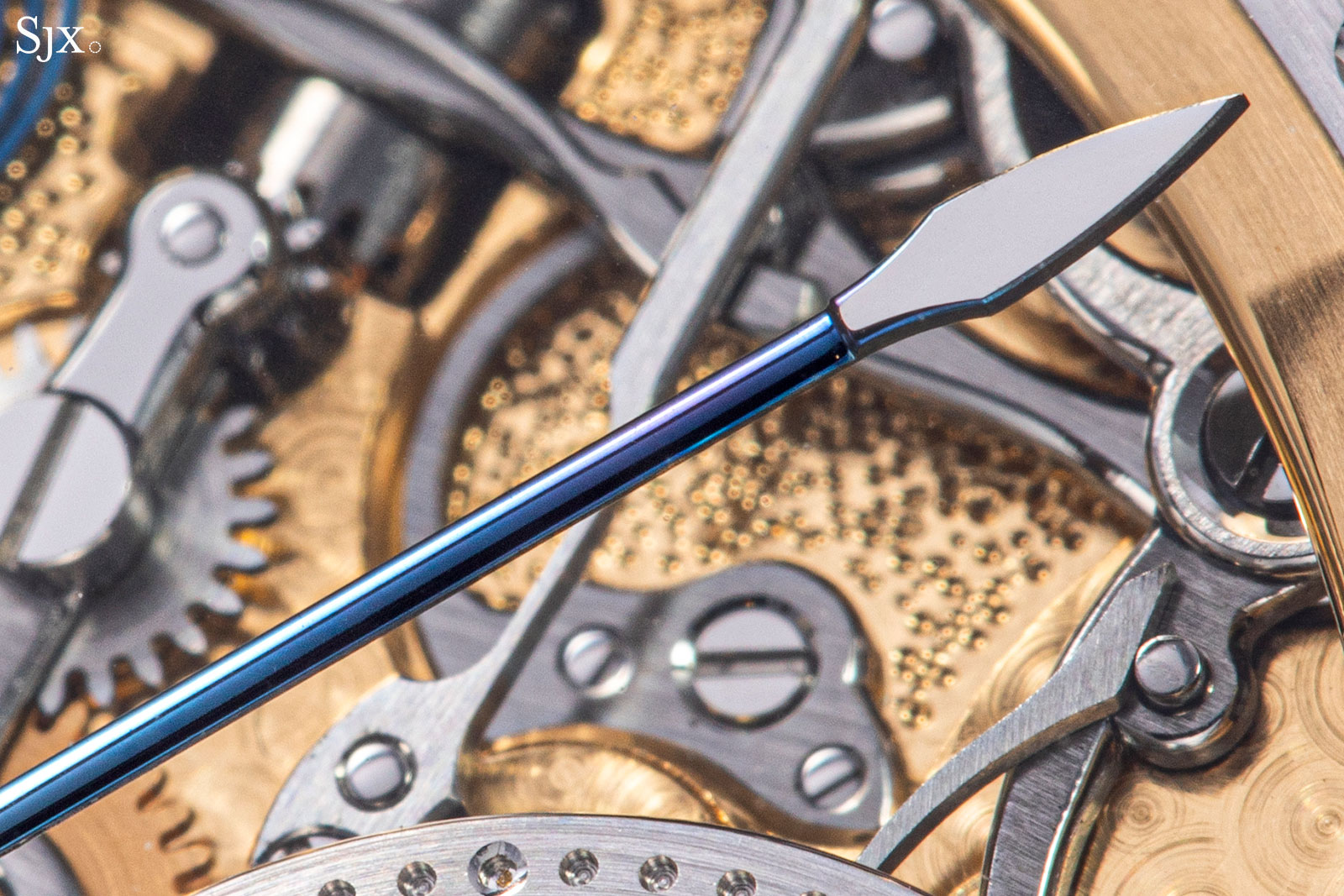
Not allowed on board a flight
A familiar sight
From the back, the movement in the AK-06 is nearly identical to the Chronometre Contemporain, with a layout that is symmetrical, classically-inspired, and packed with lovely details. But the differences between the two are obvious. Specifically, the AK-06 differs with three additional visible jewels on the barrel bridge for the power reserve mechanism, plus the larger cocks for the third wheel and balance, as well as the rounded steel cock for the fourth wheel.
While the Chronometre Contemporain movement has exaggerated inward and outward angles on the cocks for the going train, giving it a modern, attention-seeking look, the calibre in AK-o6 is ironically more restrained and classical, despite the AK case.
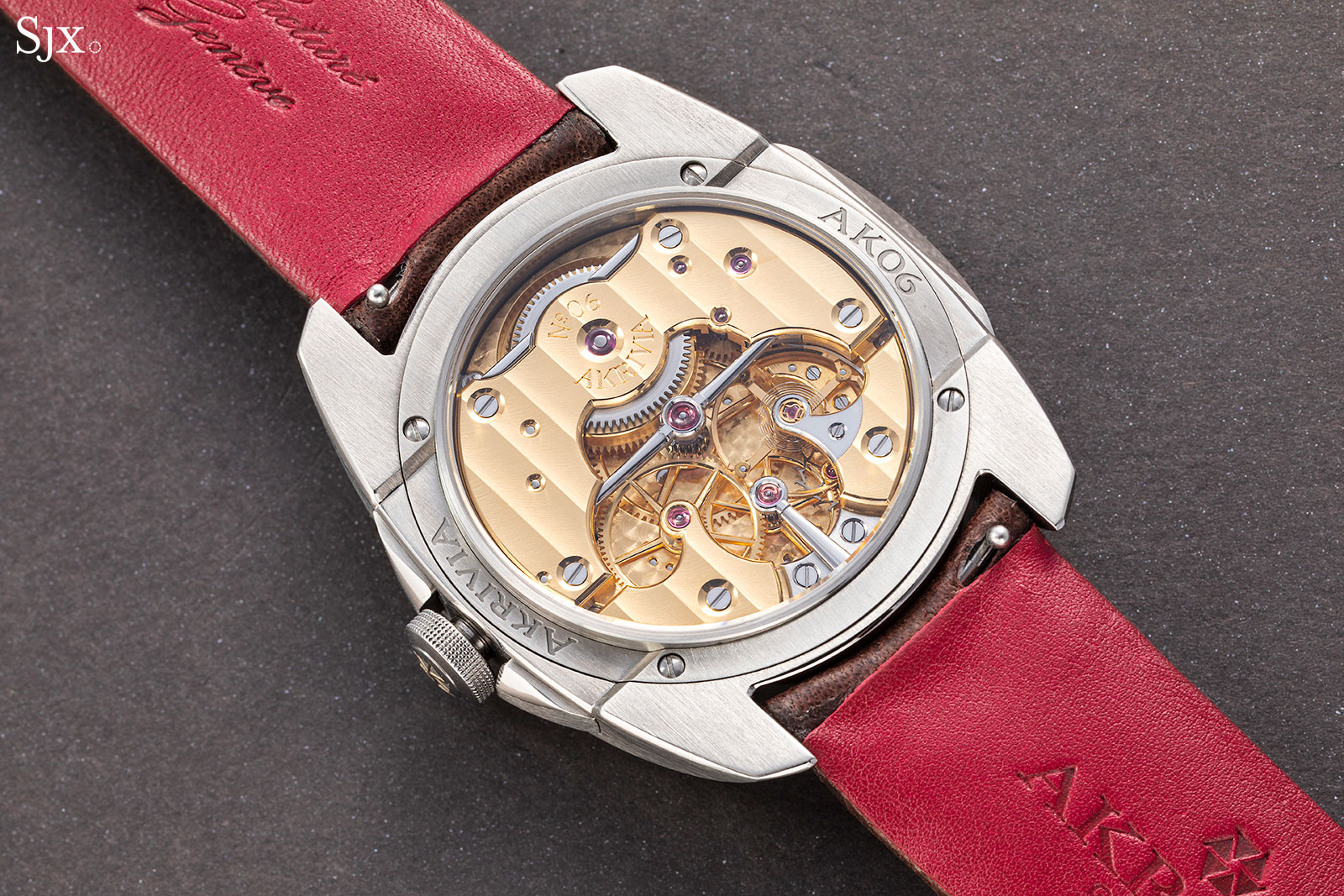
Notably, while the Chronometre Contemporain is available in just one style, the AK-06 movement is offered in two finishes – yellow-gold gilt or rhodium plating – to match each of the dial colours. Both are equally well finished, though the decoration is more obvious on the rhodium-finished movement because there is more contrast.
Though they are different, both movements are equally attractive. In fact, the AK-06 has an edge in some aspects, including the steel fourth-wheel cock that is more far more impressive than necessary. Another bonus in the AK-06 is the outermost jewel for the power reserve mechanism, which results in two additional inward angles on the bevelling of the barrel bridge.
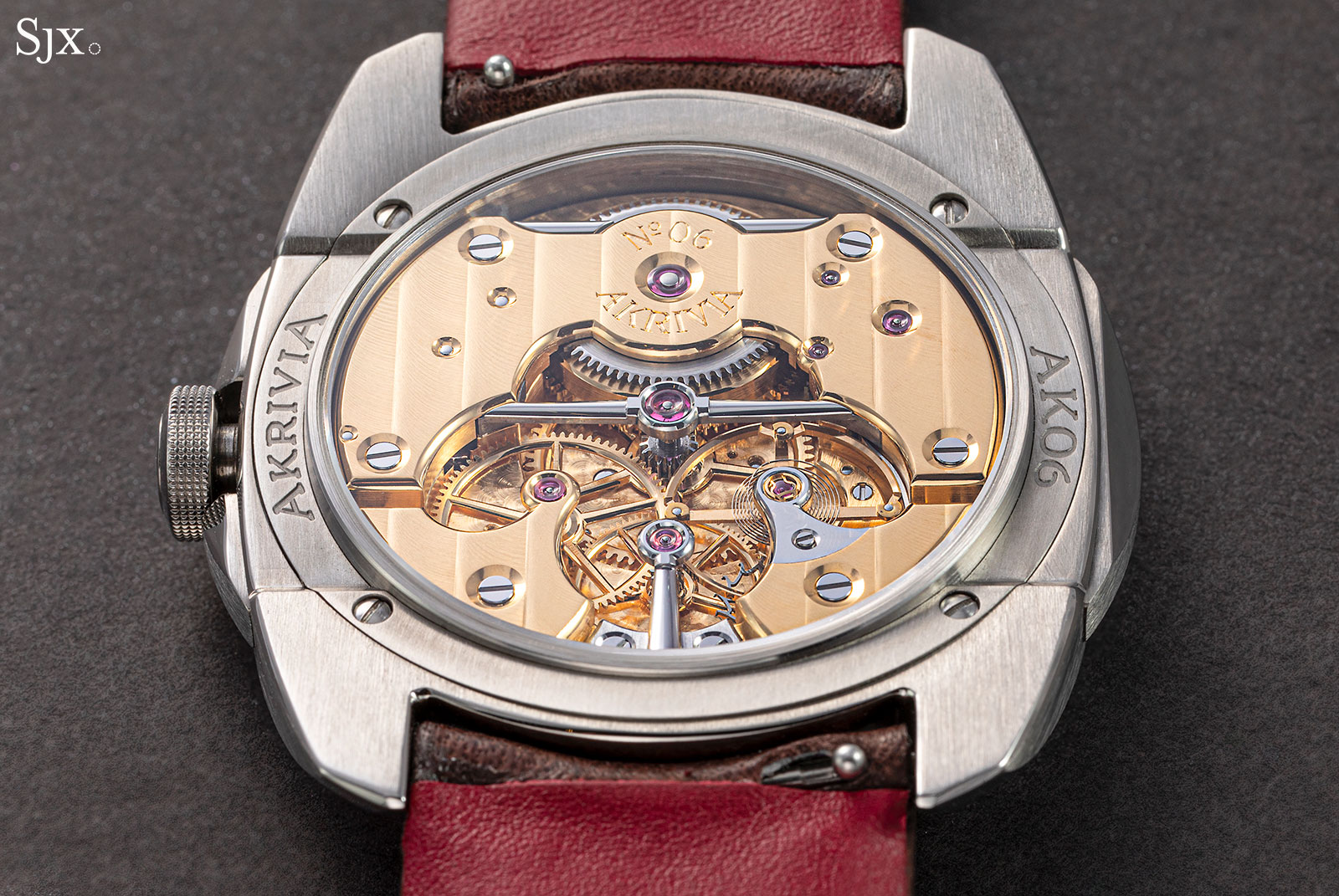
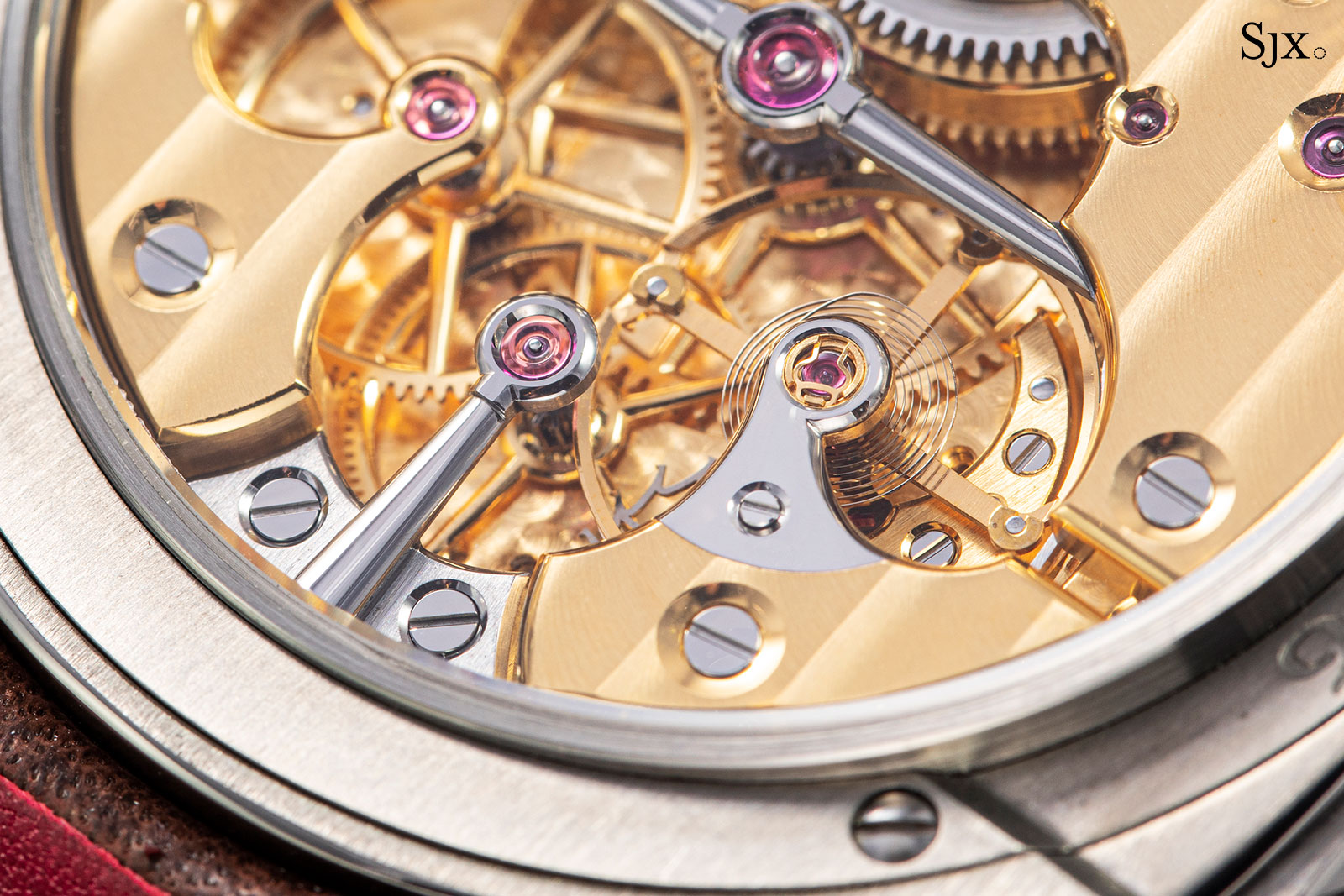
The steel cock for the fourth wheel has a rounded, polished arm, while its base is straight grained
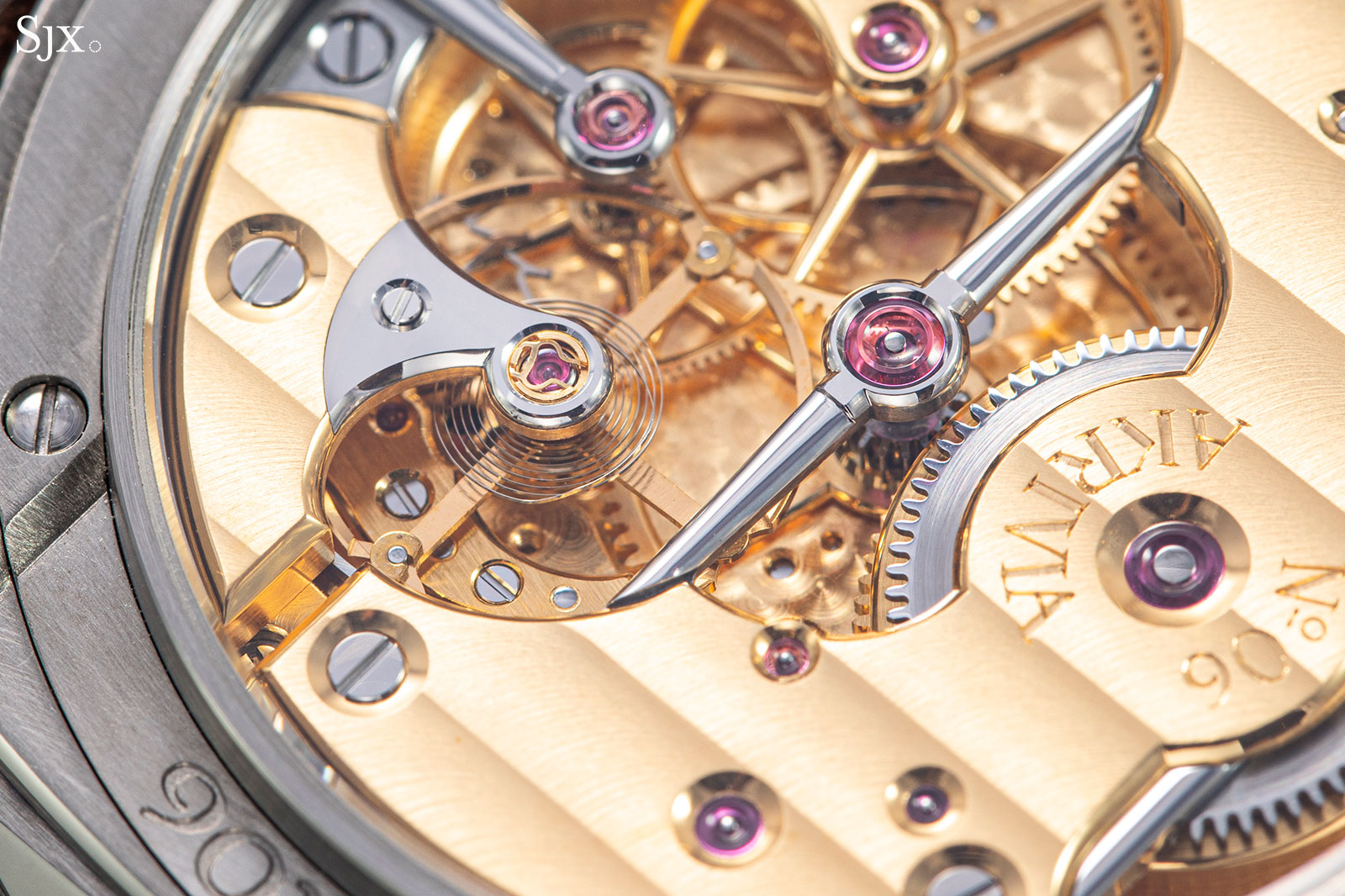
The movement is constructed on three levels, broadly speaking, giving it a surprising degree of depth for a time-only calibre. The brass bridges make up the uppermost layer, followed by the barrel and tubular steel bridges, with the wheels of the going train and oscillator making up the bottom layer.
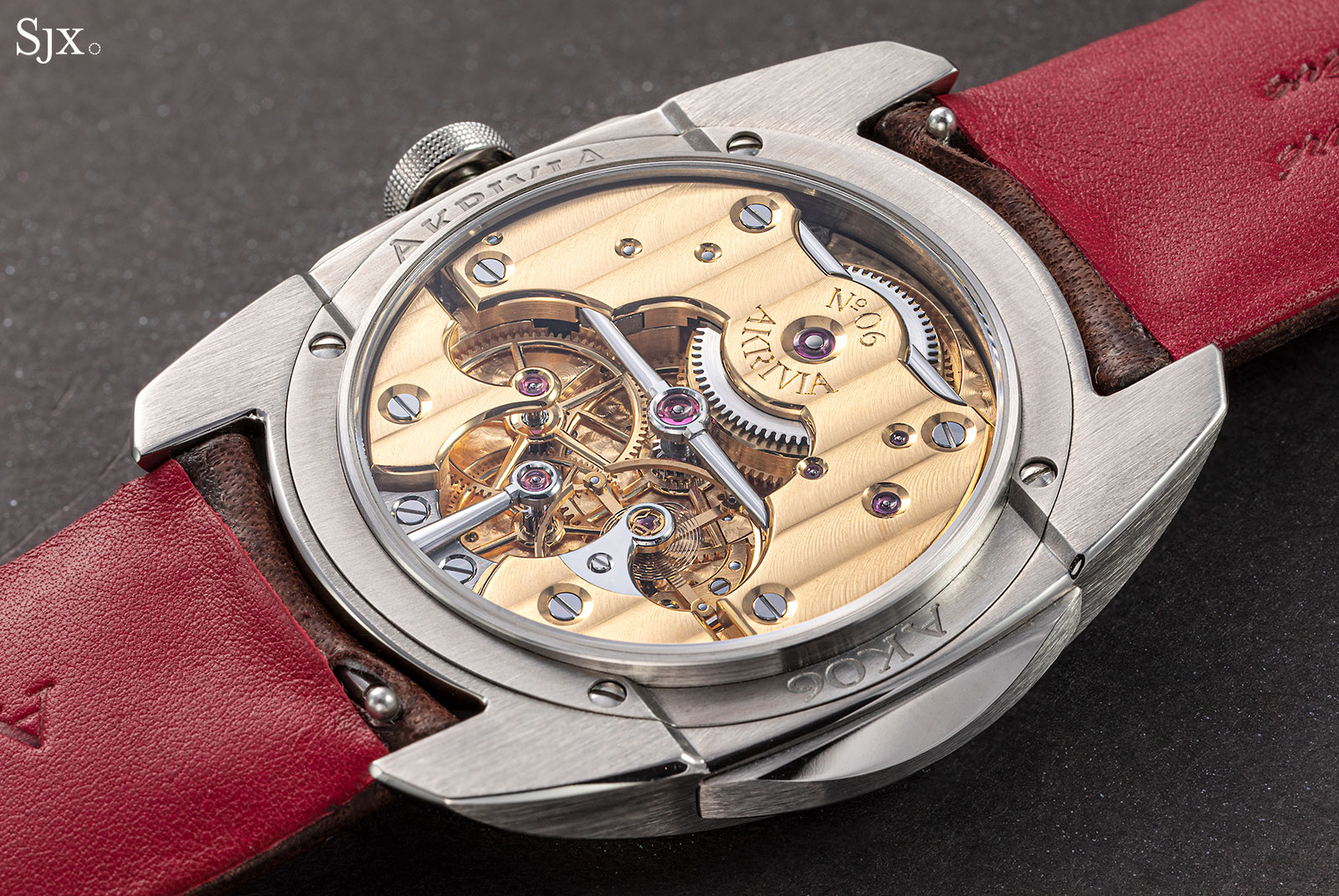
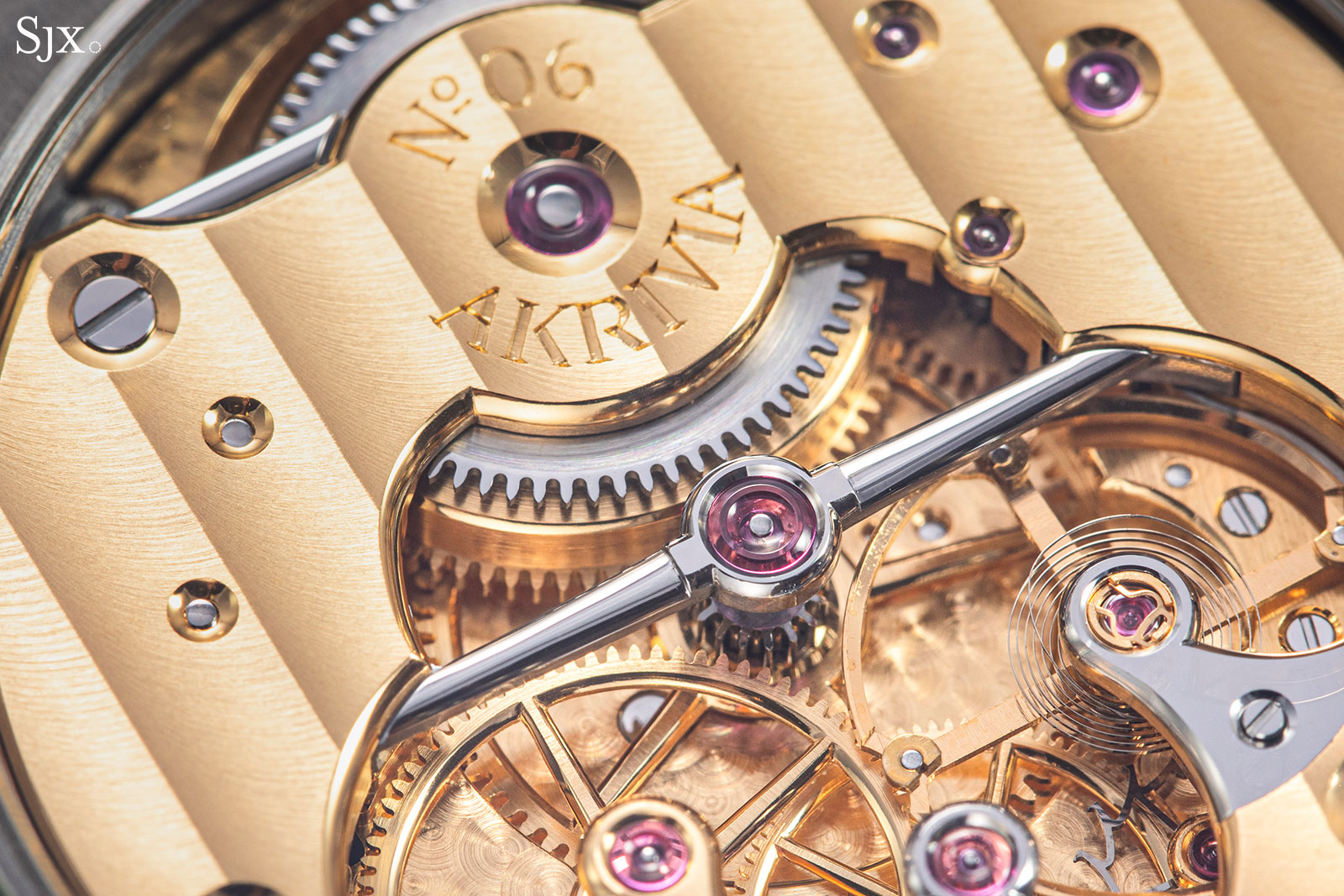
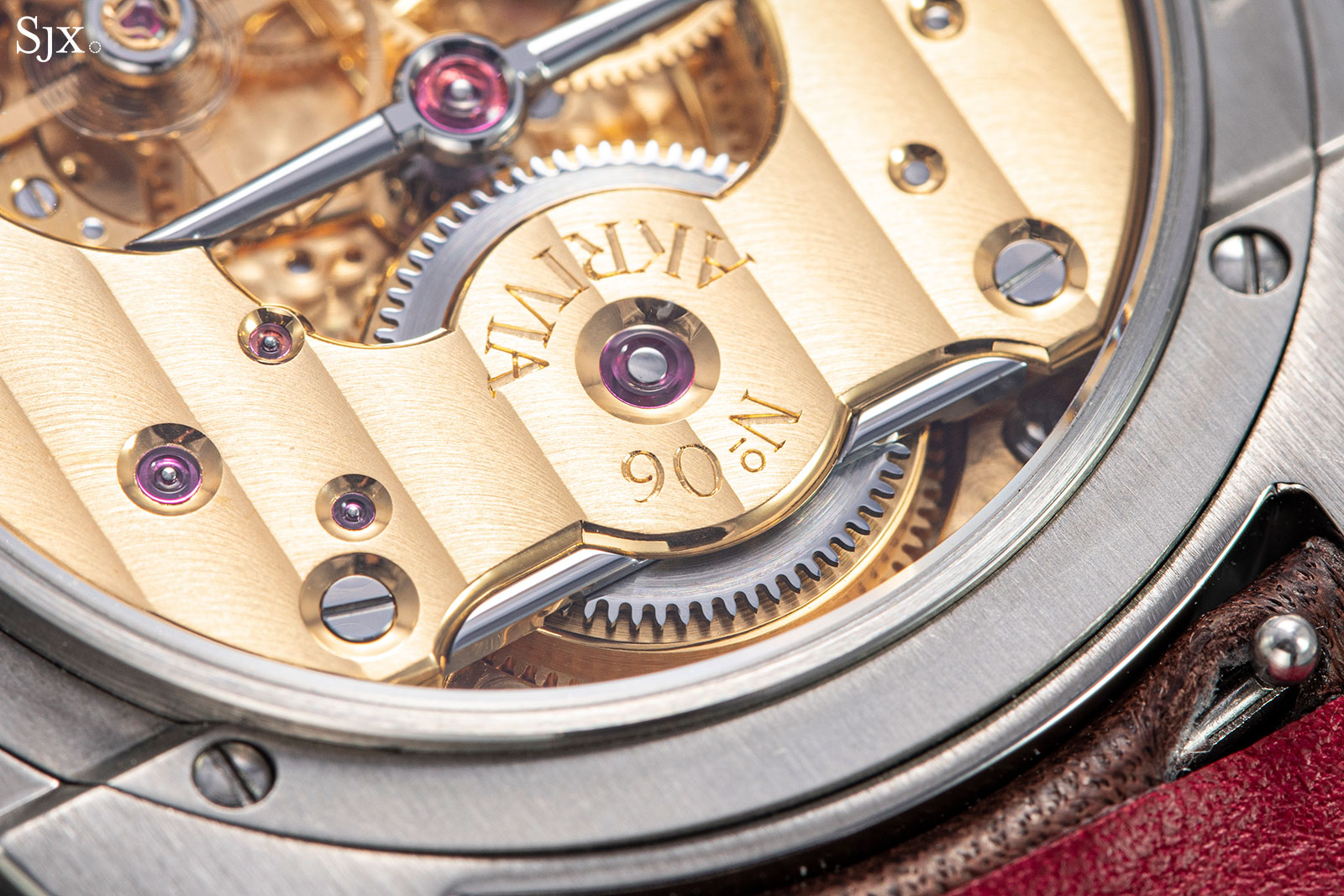
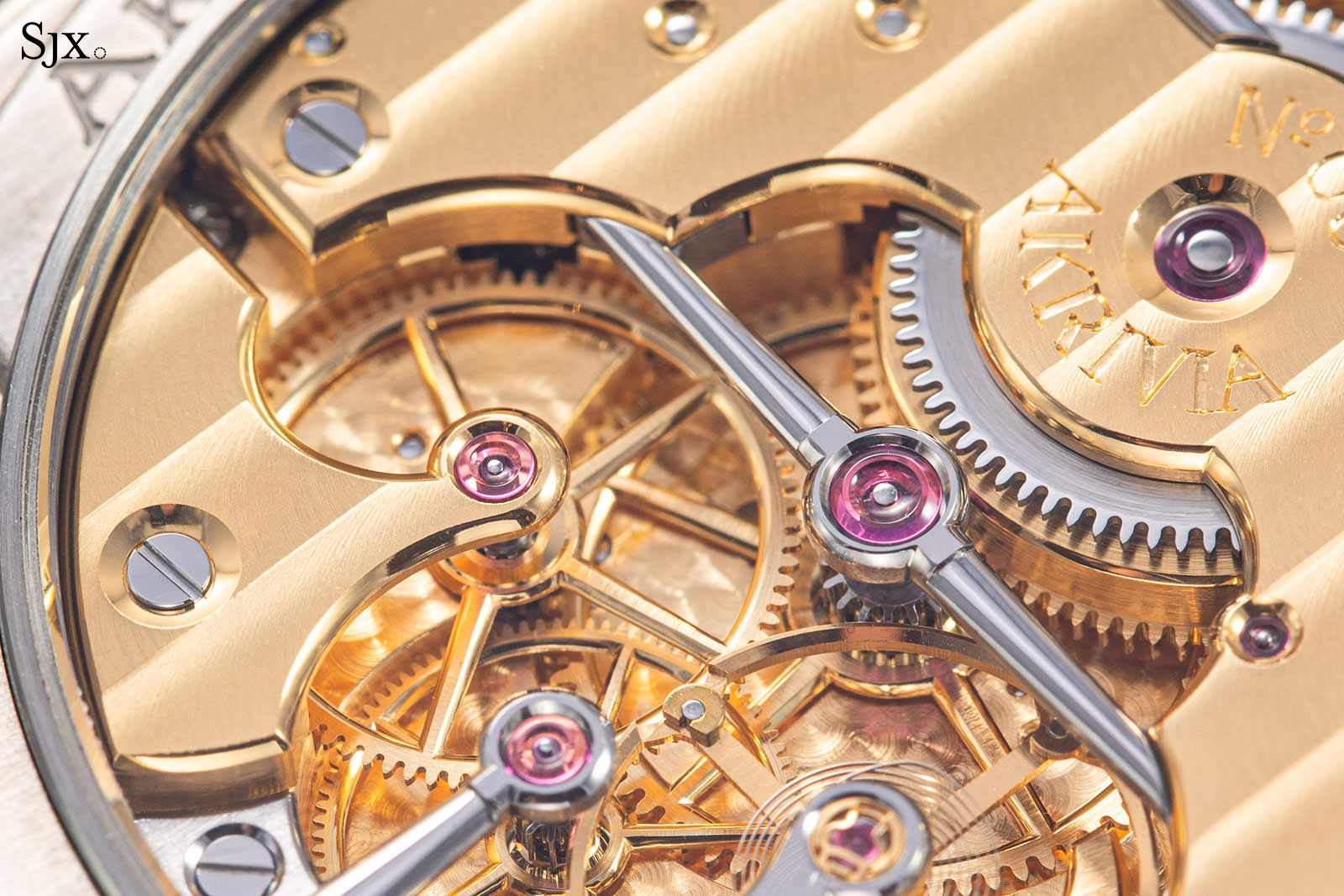
Each component on every level is finished very, very well.
The bridges have Cotes de Geneve on top, wide anglage on the edges, and bowl-shaped countersinks for all jewels and screws. Most steel parts are black polished, including the cap for the balance cock and all the screw heads, which also have chamfered edges. The list goes on – in short, everything is done right.
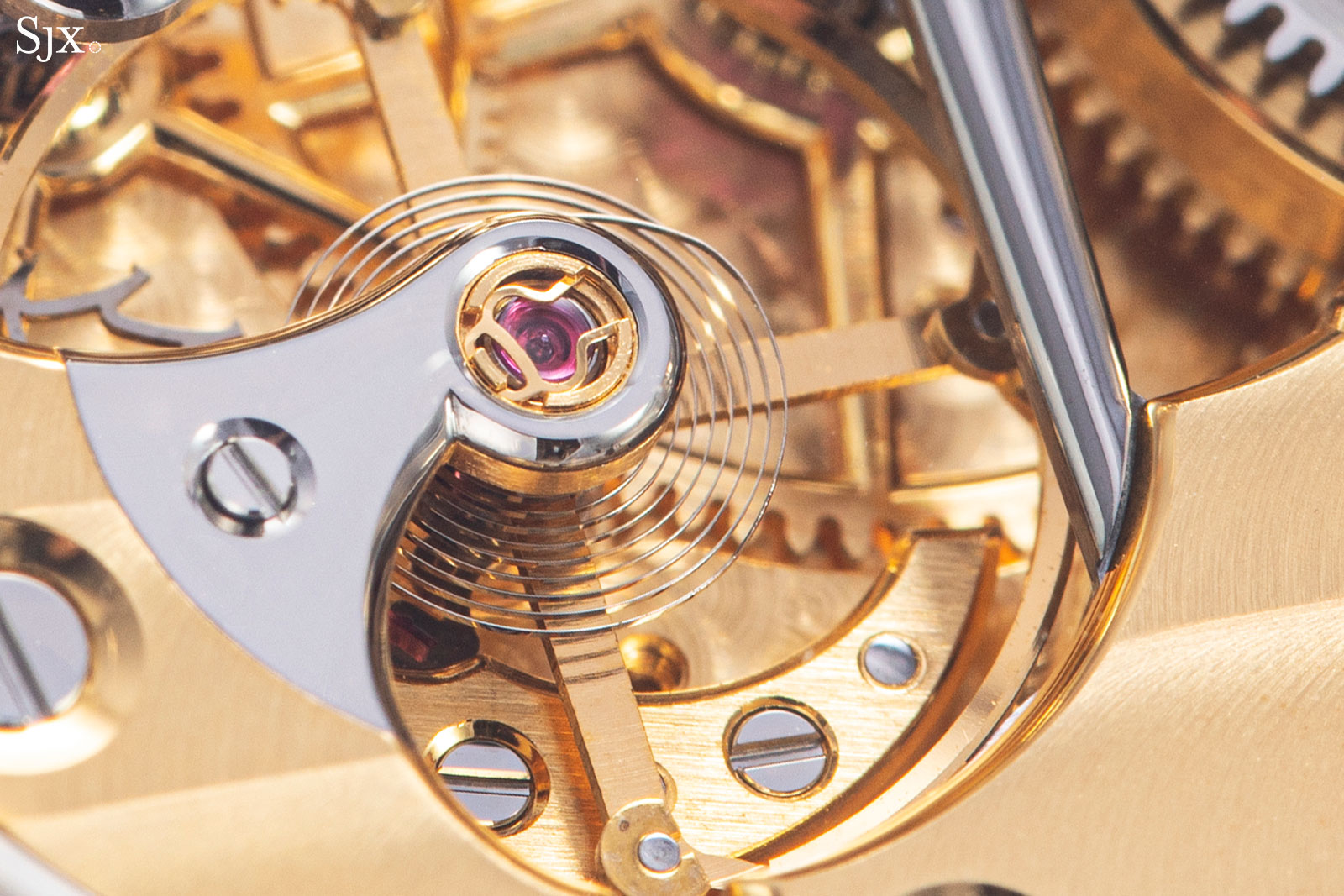
Hand-formed overcoil hairspring; note the countersinks and chamfered edges of the escape wheel bridge below the balance
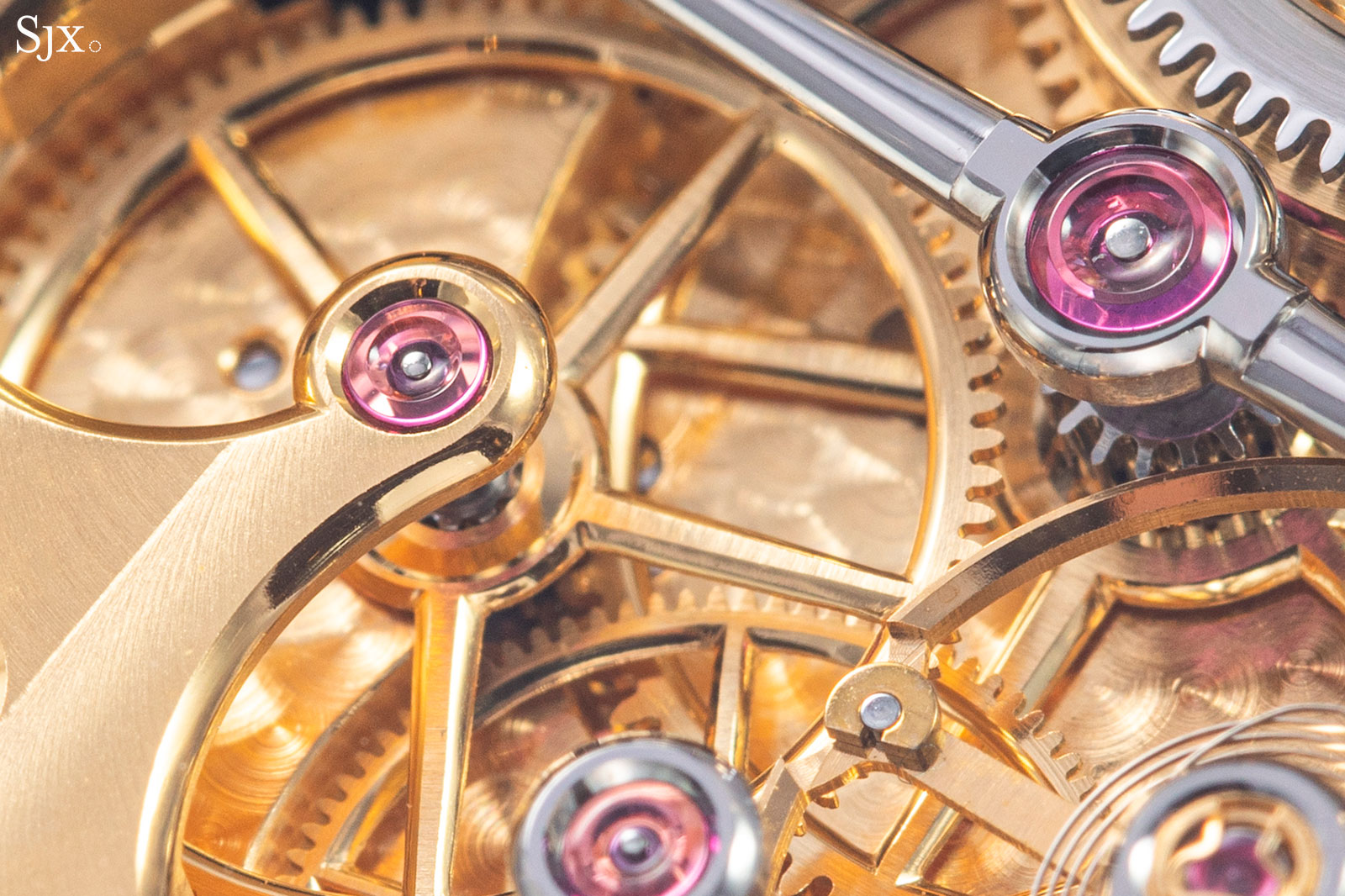
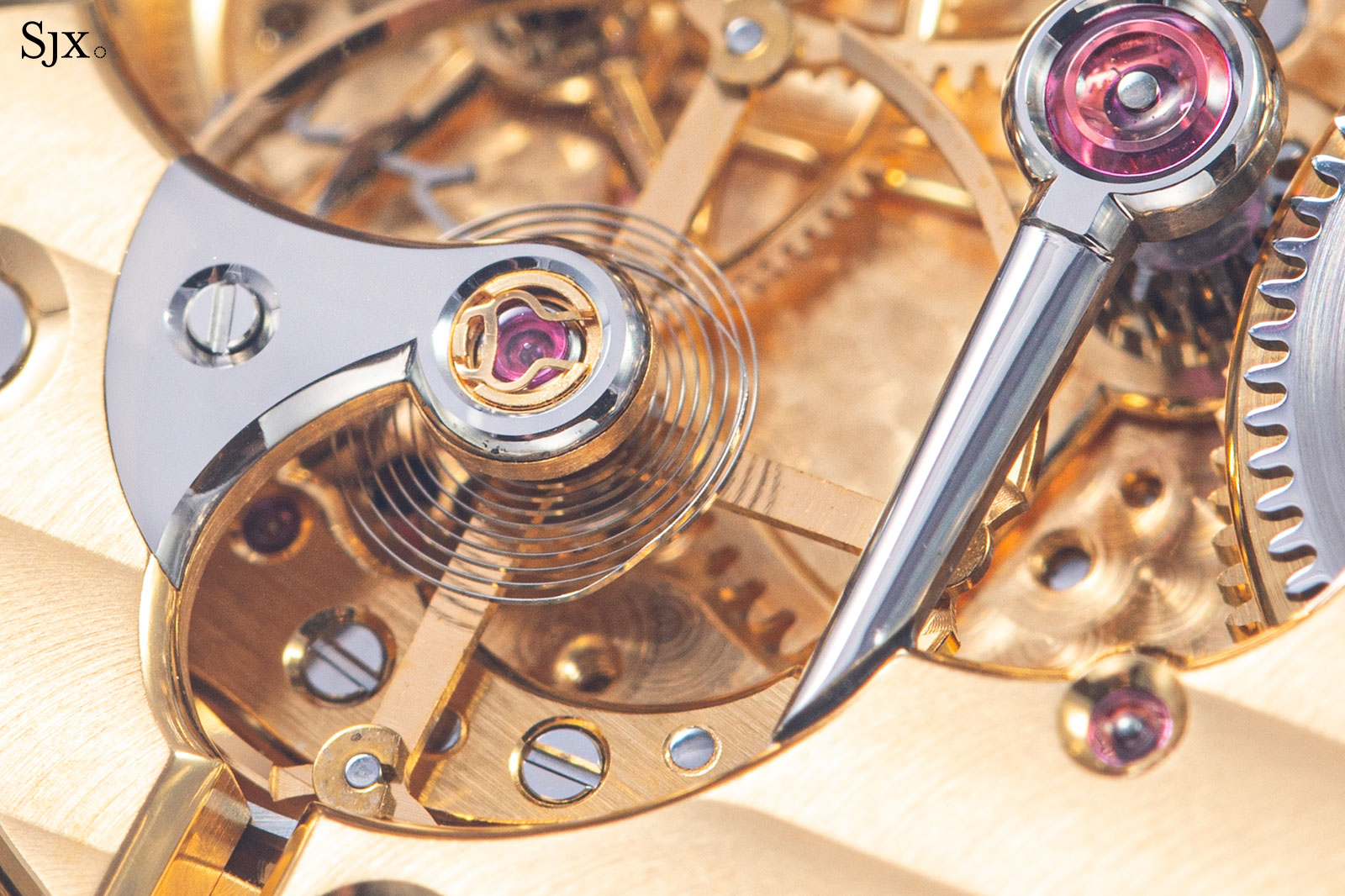
That being said, there is some variation within the AK-06 series from one example to the other, because the finishing is done by hand. The steel-case version (with a rhodium-finish movement, pictured below) has slightly wider bevelling on the spokes and inner edges of its wheels, along with more rounded teeth on the barrel ratchet wheel.
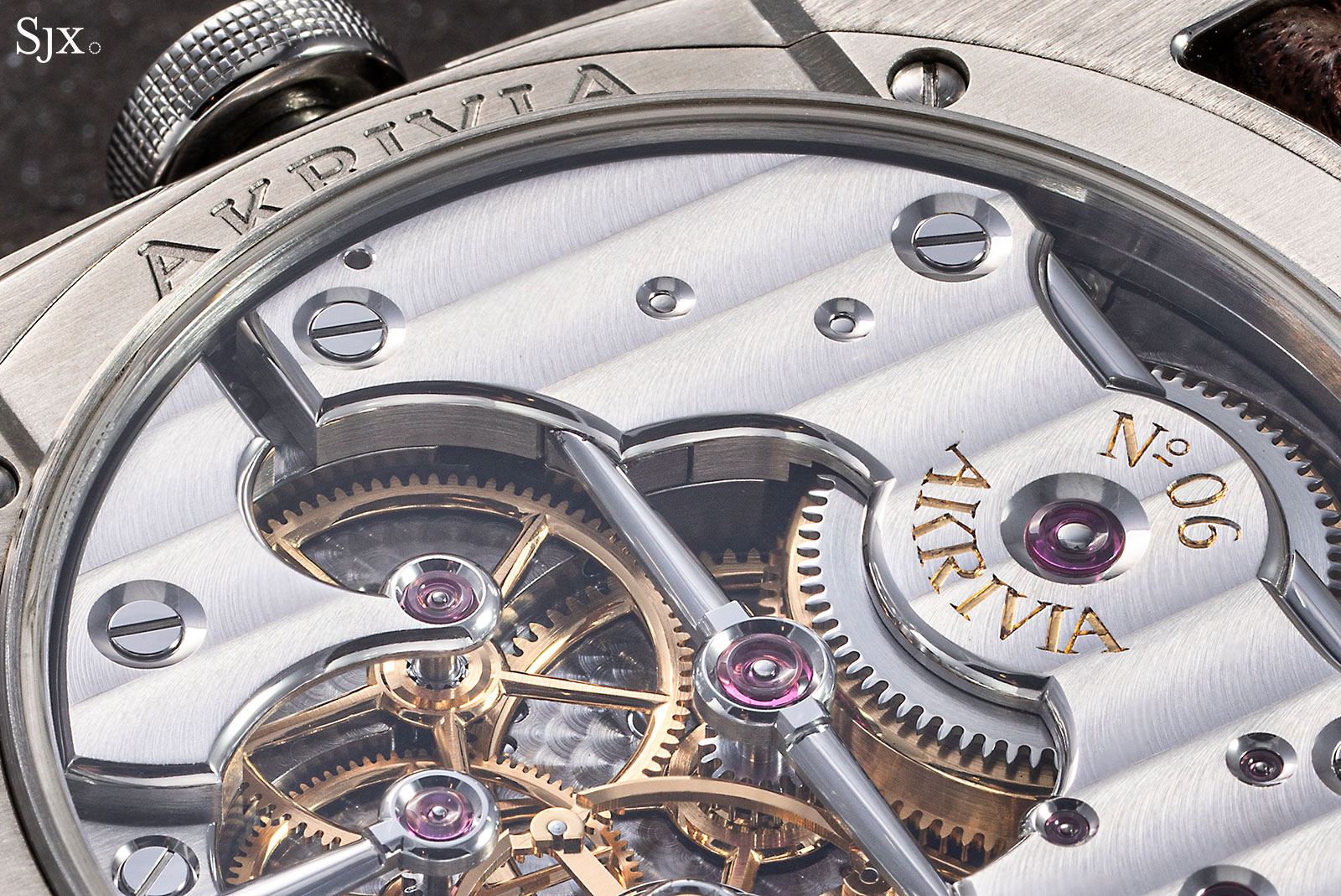
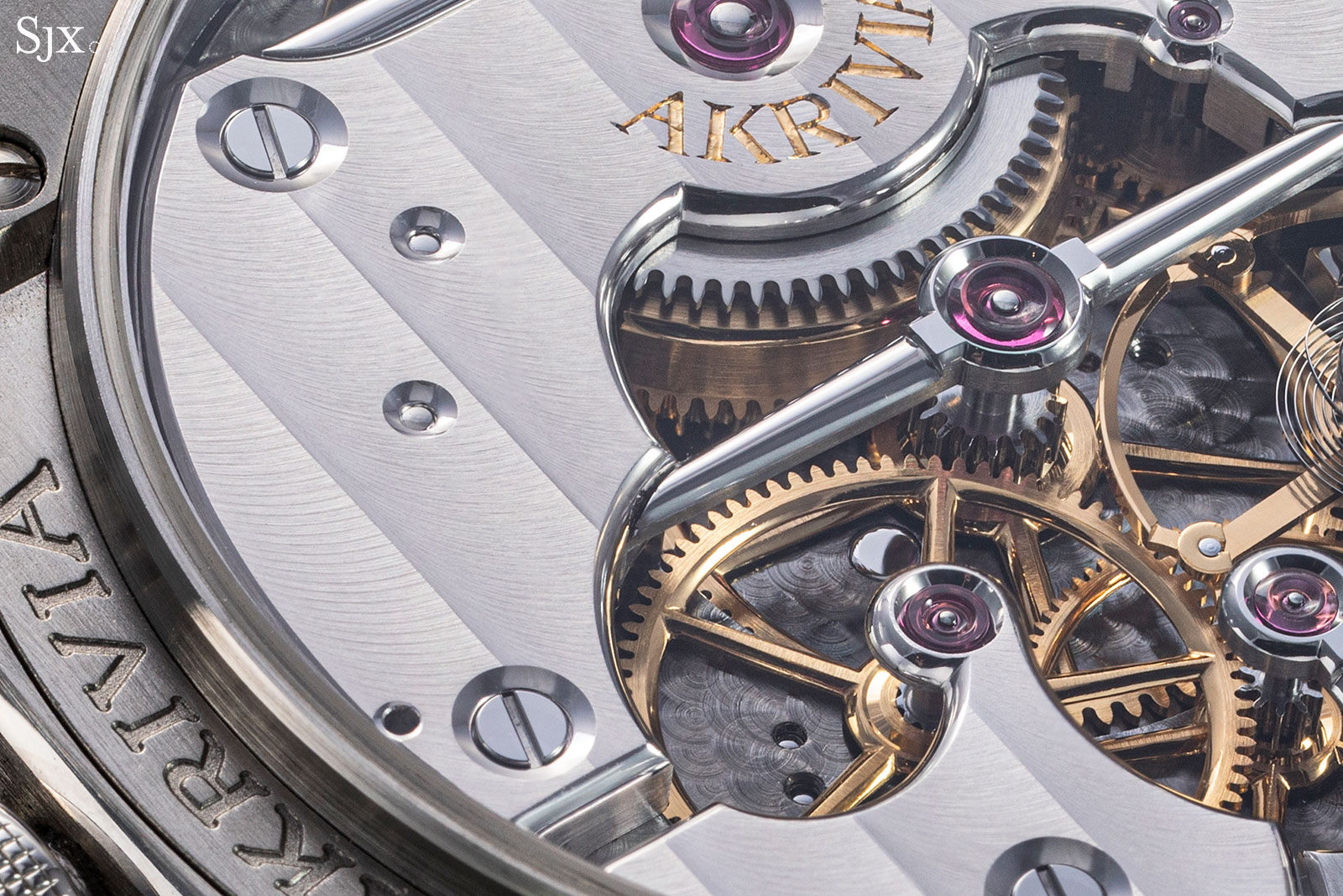
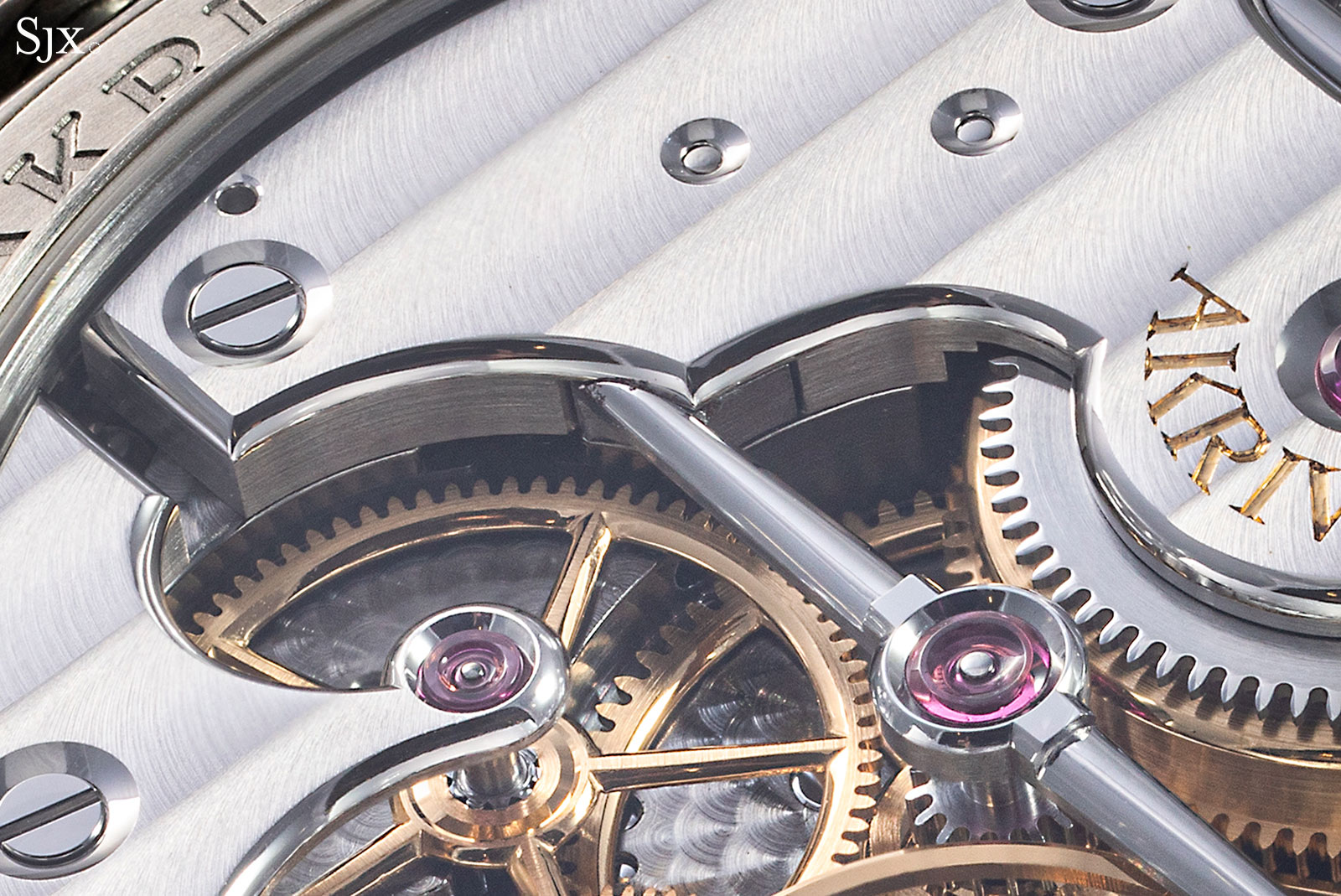
Surprisingly wide bevels on the spokes of the wheels
Concluding thoughts
In terms of finishing in both case and movement, the AK-06 is impeccable. As is typical of hand finishing, it does reveal inconsistencies here and there, ranging from the type of engraving on the front to the width of the bevels on the wheels, but the quality is still fantastic.
But the case is definitely an acquired taste. Even though the case style has its defenders, including discerning collectors who find it more compelling than the boring Chronometre Contemporain, I have yet to come round to it.
That being said, Akrivia will only produce 50 of the AK-06 – half in steel and the balance in titanium – and that will be it. The successor model will feature a different case, and a variant of the same movement, perhaps constructed a bit more elaborately, but will likely cost more. In that sense, the AK-06 represents an important moment in time, being a key watch from the early days of a brand that might become the next big thing.
Key facts
Akrivia AK-06
Diameter: 41 mm
Height: 9.9 mm
Material: Stainless steel or titanium
Water resistance: 30 m
Movement: AK-06
Functions: Hours, minutes, seconds with zero-reset, and power reserve indicator
Frequency: 18,000 beats per hour (2.5 Hz)
Winding: Hand-wound
Power reserve: 100 hours
Strap: Brown calfskin with pin buckle
Limited edition: 25 each in steel and titanium
Availability: Direct from Akrivia or at authorised retailers
Price: Starting from 79,000 Swiss francs, or 115,200 Singapore dollars, in steel
For more, visit Akrivia.com.
Correction April 4, 2020: The steel-case model has a grey dial, while the titanium version has a gold dial, instead of the opposite as published earlier. Also, the case diameter is 41 mm, and not 43 mm as stated in an earlier version of the specifications.
Back to top.
